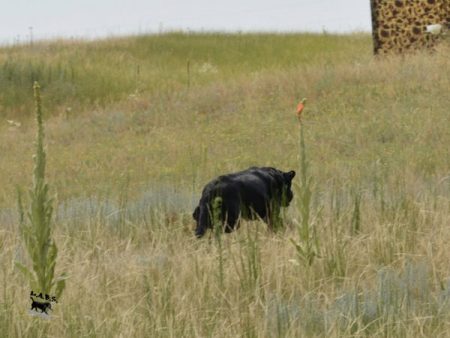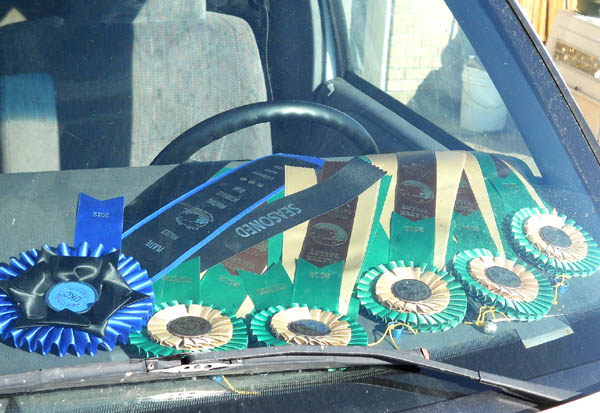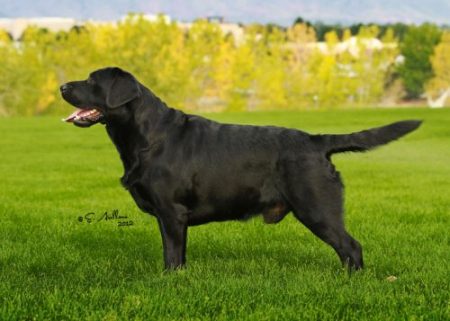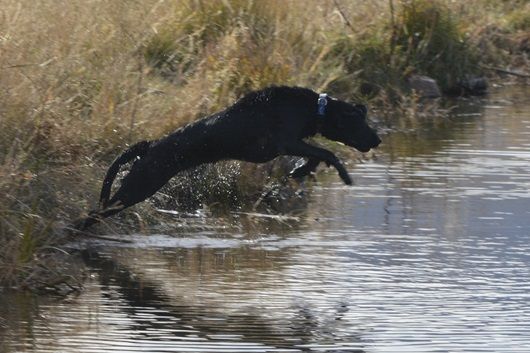Animals, birds, and even insects have thoughts. Maybe not exactly like people, but animal communicators have a gift that can tap into those thoughts.
Animal communicators are people with a psychic ability to connect with animals on a deeper level. They use their intuition and sensitivity to better understand what animals are thinking and feeling.
These thoughts may come through as words, images, or feelings. They can take that information and translate it into a form a client can understand. This helps us understand animals better and can even solve behavioral problems or improve their well-being.
By learning what an animal is trying to tell us, we can build stronger and better relationships with them.
“The animals are waiting, curious and hopeful, for us to awaken, listen, and learn.” ~ Penelope Smith
Providing insight into what animals have to say
Communicators can connect with animals on a deep level to understand their thoughts and feelings. They’re often consulted when an animal becomes ill, develops behavioral issues, or is facing the end of their life. Sometimes communicators help find lost pets or scan an animal for physical or emotional pain.
They often describe entering a meditative state of consciousness to establish a mental connection with the animal. This connection allows them to receive and interpret information from the animal and then pass the information to the animal’s caretaker.
Sometimes communicators consult over the phone which is very helpful for large animal owners or when the communicator is far away. Similar to energy work, such as Reiki, distance doesn’t matter.
Techniques used by animal communicators
The communication process is like a radio. The broadcast station sends out radio waves at a particular frequency. People need to tune to that frequency to hear the broadcast. In this case the “broadcast station” is the animal sending thoughts, images, or feelings. We need to tune to the animal’s particular “frequency.”
Researchers are studying telepathic communication. Quantum physics has proven that we are connected by waves of energy.
We already use telepathy, perhaps without realizing it. Does your dog hide when you’re planning to take him to the vet? Or perhaps waits by the door before you get his leash? You may be doing something and all of a sudden realize your dog has to go out. Maybe he ran to the door. Or he rung a bell like he’d been taught. Or maybe he told you and it just flashed in your mind.
It’s something kids do naturally and mothers do with their children. However once we learn to speak, we place more value on verbal communication rather than on intuition.
With practice we can become more aware of thoughts, images and feelings animals share with us. Paying attention to body language and non-verbal cues also helps gain insights into the animal’s thoughts and emotions. Cues might include the animal’s posture, tail position and facial expressions.
Dogs are particularly good at communicating with body language. Think of the wagging tail or bared teeth. Or when they come to you and just stare. Perhaps they’re trying to will you to hear their thoughts.
There is more to it than interpreting actions or body language. You have to be open to it and pay attention when it happens. If you doubt, you may block what information the animal is sending.
Animal communication session
I had an interesting experience a few years ago at a dog show. As I was walking out of the building, I noticed a booth for an animal communicator. I discounted it at first, but then thought “what the heck.”
At first her communications were pretty generic. She said my dog, Chip, wanted to know how long Labradors live. He told her he was glad that I took good care of him and he wanted his granddaughter to take his place someday.
Did I really believe she was talking to my dog? Not at first, but something she said turned me into a believer as I was driving home.
She told me Chip was my self-appointed protector and he wanted me to get a new truck. He wanted a truck I could see out of.
It didn’t make much sense at the time.
On the way home, Chip was in the front seat with me. He was sitting on the passenger seat when I wanted to change lanes to the right. I glanced over and told him, “Lay down, I can’t SEE.” When I realized how often I say that, I became a believer.
When I told a friend about the experience, she wasn’t surprised. She had several experiences with an animal communicator.
Once when the communicator was walking to a specific horse, she stopped at another stall for a moment. Then turned to my friend and said the mare didn’t like her new stall. She didn’t know the mare had recently been moved from a stall near the barn doors.
Telepathic connection with wild animals
The video follows Anna, a communicator, as she visited a variety of animals. First we see her joining a group of wild baboons. She walked easily amongst them. When she laid on the ground, two baboons gently picked through her hair.
Later the alpha male walked to her and asked, “Who are you?” Anna told him she was there peacefully and the male accepted her presence. This was the same male that had attacked other people who got too close to the young baboons.
She visited several other animals, but the most poignant was a black leopard. He’d been abused in a European zoo which made him suspicious and ready to hurt anyone who got near him. Although he had a large enclosure for exercise, he refused to leave the shelter.
When Anna sat near the shelter, he calmed. She learned he had been kept in a small cage which was why he didn’t want to leave the shelter. He asked Anna about two young cubs that had been caged next to him. His keepers confirmed there had been leopard cubs in that cage, but hadn’t mentioned it to Anna.
After the session with Anna, the leopard seemed more calm. He left the shelter to explore the rest of the enclosure. His keepers said he was a changed animal
The video is nearly an hour long, but you can skip ahead to 38:52 to learn more about this leopard.
Conclusion
Am I a believer? Yes. The experience with Chip was my introduction to animal communication. I’ve had more experiences since then, but there is still much to learn.
If you’re looking for animal communication services, be aware there are charlatans. Ask around for other people’s experiences. Would they recommend that person? Is that person passionate about helping animals? Are they able to help your beloved pet? Can you schedule an appointment?
Also although you may have questions, be prepared to mostly hear from your pet. They often understand us better than we understand them and they will be excited to share their thoughts.
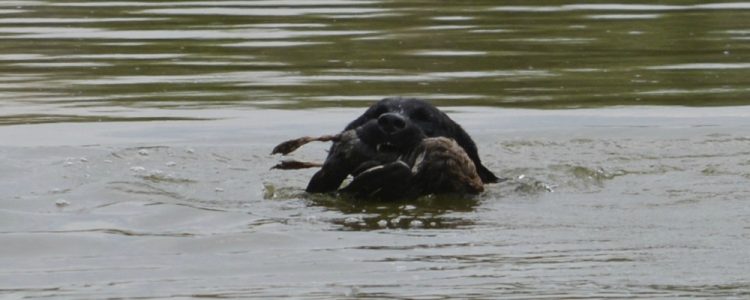
The Working Certificate – or just WC – is a fun test for Labs and their owners. One short retrieve on land and two back-to-back retrieves in water is all that’s needed.
Some Labs take to it (dare I say?) like a duck to water. Other Labs take a bit of coaxing. That’s where being a member of a local Lab club comes in handy.
There’s also a Working Certificate Excellent, or WCX test, offered by some clubs. However the LRC only offers the WC test.
A bit of history
When The Labrador Retriever Club, Inc. was founded in 1931, The Kennel Club in England required sporting dogs prove working ability. Without it they could not earn a conformation title.
Using that as a guideline, the LRC created the WC test. It isn’t a requirement under American Kennel Club rules. However the LRC requires members’ dogs to have a WC before they can be called a show champion.
Requirements of the Working Certificate test
The WC requires your dog to retrieve a single shot bird at 50 yards. Generally pheasants or ducks are used with ducks being the most common. Sometimes pigeons are used.
Usually the birds are already dead and the gunshot is just a simulation. Live birds can be used, however that requires a good gunner and scrupulous safety measures.
This isn’t a marking test like hunt tests and field trials. The core requirement is for your dog to retrieve a bird to you (or at least close to you). The judge will define how close your dog must bring the bird – generally within about five feet of you.
The retrieve doesn’t have to be to hand or fast or even pretty.
Your dog doesn’t have to be steady. You can restrain him by holding his collar or with a leash wrapped through the collar or wrapping your arms around him. For safety, the collar should not have dangling tags. They can be removed or taped securely to the collar.
Handling or directing your dog to the bird with hand signals or other commands is not permitted.
Your dog must also complete two back-to-back water retrieves to show a willingness to re-enter the water.
Download a copy of the WC brochure.
Differences between a WC and a Junior test
This is totally different from an AKC Junior test. It’s not a marking test. It’s only about retrieving. The questions is: Will your dog pick up a duck and bring it back to you?
If he drops the bird ten times, but makes progress back to you and gets the bird into your area, it’s good.
It’s a test of natural ability, not a test of how you trained your dog.
One dog’s experience at the WC
The Labrador Retriever Club of Greater Denver hosted a Working Certificate test near Franktown, Colorado. The property was nicely set up for retriever training. Lots of people and dogs turned out for fresh air and some rather ‘moist’ skies!
Wynk started off with one mark on land – near the top of a little hill – no problem. But there was something new, something she’d never seen before. A blind (camo fabric) out in the field, hiding people.
‘What’s that?,’ she asked. So she had to go take a peek and say hello to the bird boys. Then remembered she had to get her bird back to mom! Scooped it up as she ran back and delivered to hand. Land portion completed!
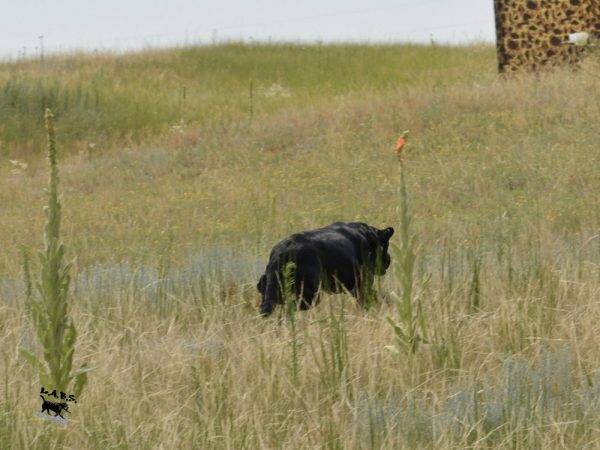
After a bit, we worked the water portion – back to back retrieves in a pond enclosed by tall reeds and other vegetation.
Another new experience for Wynk.
Out and back, delivered to hand for each mark, with her signature squeal as she left the line. Quite proud of my little Lab!
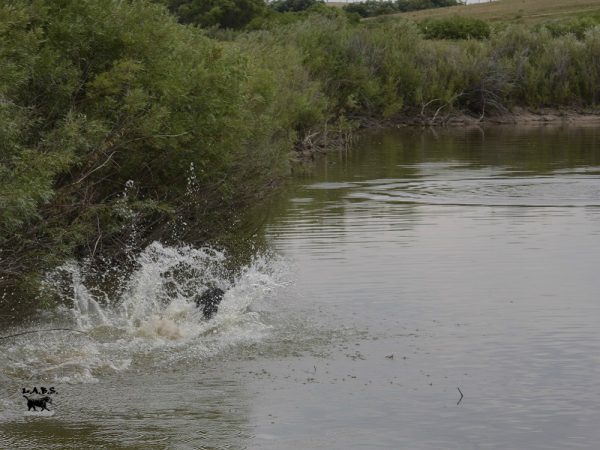
Photos by Linda Alexander.
Preparing for the Working Certificate test
Let’s dive in to the what and how.
Lab clubs often have training days in preparation for an upcoming WC test. If you’re not a member of one you can check for local Lab clubs.
If there isn’t a Lab club nearby, try contacting other retriever clubs. Their training could be different than training for an LRC WC, but they may be able to accommodate your needs. Especially if you volunteer to help set up, throw birds, run a winger station, or tear down.
As a last resort, you can practice on your own. You will need at least one duck and a helper to throw the bird. To start, put your dog on leash and let him see and smell the bird. Waggle it around to get him interested, then toss it about five feet as you run out with him. Praise him for running to it. Praise for picking it up. Let him hold it for a bit. Then repeat, but no more than two or three times.
If it didn’t go too well, try being more excited. Waggle the bird more. Pretend you’re playing keep-away. Have your dog, on leash, watch another dog retrieve the bird. Praise for every tiny improvement.
To use the bird for multiple sessions, wrap it in newspaper and put it in a plastic bag. It will last longer if you freeze it in between sessions. You may also want to warn your family about the foreign object in the freezer.
Land retrieve
Your dog’s manners getting from the holding blind to the line don’t count. Just keep a firm grip on the leash.
It’s a fairly short retrieve of about 50 yards.
The gunner often wears white to be very visible.
Get your dog to sit or stand next to you and facing the gunner. Take your time. When you’re ready, restrain your dog in any way you want. Then signal or say you’re ready.
After that the judge will signal for the gunner to start. Wait for the judge to release you by saying your number or something like “dog.” This gives the judge time to call a “no bird” if something went wrong. You don’t have to release your dog immediately.
The bird will be thrown into light cover and should be relatively easy for your dog to find. There could be a small hunt or, in some cases, a big hunt.
You can encourage your dog. Find it, fetch it up, where is it? are all good. You can use a whistle. You can do almost anything you want to get your dog to pick up the bird and bring it back. Ask the judge if you’re not sure.
The main objective is for your dog to pick up the bird and bring it back to you. The judge may require him to cross a specific line or he might have an area marked out.
Your dog can sit at heel and present the bird. Or drop it near you. Or, if you’re quick and agile enough, you can snag the bird as your dog rockets by you.
Any way you get it, hand the bird to the judge or a “bird boy” and you’re done. For now.
Water retrieves
These test whether your dog will re-enter the water after retrieving the first bird. Again it’s not a marking test. The core requirement is for him to go back in the water to retrieve a second bird.
Each bird is thrown and retrieved separately. It’s not like a double marked test.
Your dog doesn’t have to deliver to hand, but should bring the bird up onto dry land. He can be coaxed if needed to get him into the receiving area. He can also run the bank, but must bring the bird to you.
There’s no rush to do the second retrieve. Get your dog under control and looking out where the next bird is going to be. Signal for the bird when you’re ready.
Once your dog has delivered the second bird to the area of the handler, you’re done. Take a breath!
After all the dogs have run, and your dog passed, you will get a form signed by the judge(s). Send that form to the LRC with the fee (currently $25) to get your working certificate. Some clubs give out their own certificate and/or a rosette to passing dogs to commemorate their success.
Other ways to earn a WC
If there isn’t a Lab club near you that hosts WC tests, here are some alternatives:
- Complete both a land and water series in an AKC licensed field trial or receive a placement or judge’s award of merit in an AKC licensed field trial
- Complete an AKC Junior hunter title
- Earn one leg in an AKC Senior or Master test
And there you have it!
The WC test is a great way to get a feel for running a dog in field events. Young people are encouraged to give it a try. Many experienced handlers had their first taste of field events at a WC test.
It’s also a good way for reputable breeders to show the working ability of their dogs. And it gives Lab owners appreciation for their dog’s abilities without a big commitment to field training.
I hope you will get involved in field work with your Lab. Happy training!
—
This article was originally published on July 24, 2018. Updated on May 10, 2024.
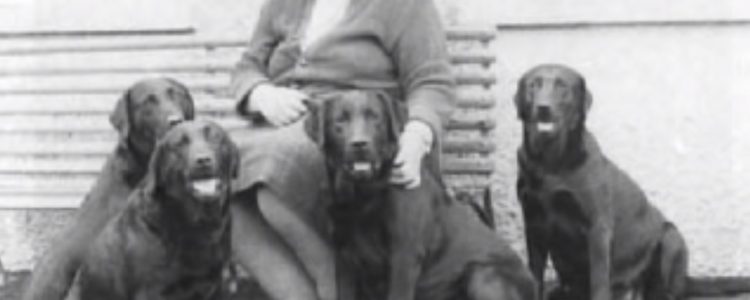
Mary Roslin Williams of Mansergh Gundogs
She bred Labs, she hunted over Labs, she competed with Labs and she taught about Labs. She had seven generations of champions, and 15 or so dogs who won field trial awards.
In the early days, she lived in Mansergh Parish, just south of the Lake District in England.
Mary Roslin Williams taught from practical experience and common sense.
Although she’s no longer with us, she left behind knowledge that she shared. Read a bit and then take a half hour to listen.
The start of the show/field divide
“I started this book by pointing out that at any one time there are about twenty top breeders who can and do stay at the top for many years, but when I come to the breeders who can show their dogs as Championship show-prize winners and also run them in Trials as Trial dogs, accepted as such by the Trial people and not called ‘Bl—y show dogs’ as is their wont, then I find it hard to name twenty kennels that can do this in the last forty years.
“Before the last War there were plenty of strains capable of doing this, indeed it was more or less the norm. The whole atmosphere of Labrador breeding was different, with such people as Lorna, Countess Howe seeing to it that the show Labrador remained a working dog. … The dogs were good-looking on proper Labrador lines, they were thoroughly experienced shooting dogs and cut out their own work with the minimum of help from their handlers, although always ready to take the hint when they were stuck. The good work on the day was put in by the dogs and not the handlers, and while Lady Howe was alive this happy state of affairs, when Trials were fun and you and your dogs welcome, remained until the sad day she died, when we immediately feared and experienced the Great Divide, into entirely show bloodlines and entirely Field Trial, poles apart.”
A water dog
“It’s a great sadness to me, that when they named the Labrador they didn’t call it the ‘Labrador Water Retriever’ … because we forget that the dog is a water dog.
“It’s job was water work. It’s job still is water work and we’ve adopted it and adapted it for different works. But in many countries that we sell our puppies to … they expect that dog to work in water. Very largely. And if you sell a dog to Canada it will be working in water in terrible frost. In cold water. Hours at a time. We ought to remember that, both when we breed and when we judge….
Defining type
“The next thing is the Labrador is a Labrador. Now here is a difficult thing because this is type and however much you have a standard, one thing it cannot describe is type. You’ve got to have type in your head. … Perhaps type varies a little from country to country. …
“My criterion for Labrador type is a very simple one. It must look like a Labrador. It mustn’t look like a Foxhound. It mustn’t look like a Pointer … It mustn’t look like a Golden Retriever. …
Pointer
“You get unmanageability. It’s an outward bound dog. It’s horizon is 300 yards away. It’s hind legs make it gallop because they can’t help galloping. It’s head is held too high. It’s elbow is angulated for a high head carriage and you don’t want it in a Labrador. We used to get it. And besides that we’ve always got a very, very short coat.”
Foxhound
“The Foxhounds came in deliberately. … And what came with it? Arrogance… When he went to judgment, instead of looking at you like a Labrador should – they did that (turned head away) – with the proudest, most arrogant expression. Now that got into the breed very badly, so that we had championship show judges writing in their critique … correct arrogant expression…. It’s absolutely wrong.
“And the other terrible fault we got in there was that they were very fastidious. … They did not like opening their mouths in dirty water. I can’t blame them. I don’t like opening my mouth in dirty water. And I don’t intend to which is why I have a dog…”
Flatcoat
“Now the next thing that happened was that somebody realized this and they quietly moved in a Flatcoat. Now that did a power of good. But we had a Flatcoat influence. One of the reasons why I hate a black eye in a Labrador was that was brought in. We brought in narrow heads, Flatcoat eyes. Flatcoat shaped eyes. And we had a lot of feathering….
“Labrador breeders are so sensible they can get these things out. It took some years and we left the good points in. We lost the arrogance. We lost the hardness and we got dogs that would retrieve nicely again…”
Greyhound
“Now the next thing that came in – and I don’t know where it came in – and I could never get Ronnie Hill to tell me, but what he knew was that the trial people introduced Greyhound. And they introduced Greyhound purely to get the speed.
“Now that influence is still with us. And if you look at the trial Labradors, you’ll see that a lot of them have very, very beautiful necks and shoulders. Marvelous necks. Way, way beyond our reach of neck. Really beautiful necks and shoulders. And they have the deep body, then the tell-tale arch over the loin. And that is the most difficult thing to breed out, to get the field trial arch out of the loin. And then they have long, thin tails and single coats. …
“So I’m warning you, if you use field trial lines you get the virtues, you get the faults, but worse still you get their diseases. And this is why I am so against any Labrador looking like anything – or particularly feeling like anything – when you’re judging that isn’t a Labrador. But as you get in other breeds and you will get in diseases …
“So therefore my first Labrador has been a water dog. My second Labrador, for heaven sake, let it be a Labrador and let it look like a Labrador. Let it behave like a Labrador and feel like a Labrador and work like a Labrador.”
Importance of a correct coat
“… I do wish that everybody … would remember that the Labrador is a cold, wet weather dog and that he’s a water dog. And that it should be able to go out duck flighting in January in bitter, bitter weather sitting at the bottom of a cut in the sand with water up to its belly or even up to its neck. The tide coming in or out and it has to sit there for while the duck flighting in. A it is cold and it is wet and the dog must be able to stand it.
“…Please remember that that is the job of a Labrador. And they should have a proper coat. And it should coat them all over. [Some dogs] are half coated. They have a hard, hard ripple like a table runner down their backs. Very, very hard hair and they have nothing else. … And that is not a Labrador coat. The Labrador coat should cover all over to the same depth and be dense, but they’re very, very difficult to find now…
Why correct structure is important
“… a Labrador’s job is not to hunt in front of you, flushing rabbits, flushing pheasants, however good.
“It is not to be a guide dog for the blind.
“It is not to be a dog for finding drugs or any of these useful things [like] finding … a dead body… That’s not it’s job.
“It’s very nice of it to do it… but it is not it’s job.
“It’s job is to sit or walk at heel until told to go. And it’s only told to go either at the end of the drive or when the bird comes down if you’re in … a duck blind … and you want it to go. …”
A level back
“And for that you need a dog bred on exactly classical lines. And a classical line is a level back, not a rake. A level back. Any retrieving dog that has to also mark should have a level back. …
The neck
“It should have a longer back to its neck than to it’s throatline. … It should have an 11″ back to its neck and a 4″ throatline, not an 11″ throatline and 4” back.
“If it was a horse it would be putting it’s ear in your mouth…
“It’s very dangerous for a Labrador to have that enormous exposed windpipe… And then when they pick their bird, it stands to reason that… the long line is on the top and the short line is underneath.
The shoulders and angulation
“Now the shoulders should be laid back and this is very important too.
“In a pointing setter, they have a laid back shoulder. Fair enough. But they don’t have the classical right angle at the point of the shoulder. They are over angulated… We want the right angle or thereabouts give or take a few degrees.
“If you have a laid back shoulder, a right angle there and a level back … the foreleg comes back under the girth. It’s not under their ear and neither is it straight under the point of the shoulder. It is back and the elbow is under the girth.
“So there you have the exact angulation that the dog can easily mark the bird when he’s walking because it’s easy for him to have his head up. He can get a scent within a reasonable distance… and then put his head down. And he can get his head down perfectly easily without having to put his elbow out… So therefore you’ve got a perfect mechanism there.
“And he must have that long line on the top of his neck to pick his bird. He then picks his bird – which takes a lot of strength – and gets it back onto the layback of his shoulders easily carrying it on the layback of his shoulders.
“So if you have the classical front, that is exactly right for a Labrador, a Golden, a Flatcoat, a Curly, a Ches, but it isn’t right for a Pointer and Setter. And it isn’t right for a Foxhound. They have their own fronts, slightly open.
An example of why it matters
“… if you have an over angulated shoulder with open angles, like a Pointer and Setter – I’m citing one of my own dogs now.
“I had a lovely dog name Tarmac … and a very good worker. But I can cite him because he was wrongly made.
“He had a marvelously erect shoulder. He then had a raked back. And the consequence was that he was over angulated behind so that he had too much stifle and too much hock – too long a hock – and it was too far behind him. And that is what happens when you get a raked back.
“Now that was the most rightful inconvenience to him when he was swimming because he swam like a Pointer. …
“He was all right once he got the bird in his mouth, but when he didn’t have a bird in his mouth the fact that he didn’t have a level back and that he had an over angulated hind legs…, he had difficulty in the water work. So I know from experience that is not a good thing. …
“At one time because we had a craze for very, very short backs – which … is not short coupled, the word ‘short-coupled’ means the loin. … they were absolutely cramming dogs so close together that they had no where to put their feet when they ran. .. They were crabbing and they had a very short line … from the point of the hip to the point of the buttock, they had no rumps whatsoever.
“And I am quite certain for work – particularly swimming – you must have a decent balanced length from the point of the hip to the point of the buttock. …
Stance
“Now if you’ve got your backline right, then you’re going to have your angulation just about right.
“And it’s well to remember – again – that a Labrador is not meant to stand with it’s legs out behind it like a Pointer or a Setter. They’re meant to stand more or less under the point of the buttock. “In other words the dog is standing slightly over his leg and he mustn’t stand sickle-hocked with his feet too far forward.
“And a very important point, … for a perfectly balanced dog … from the hock to the ground … should be at exact right angles to the ground – not stretched out back, nor sickle underneath. …
“If that dog drops it’s hock correctly, then it is standing absolutely correct on it’s feet and you’re less likely to have foot trouble.
“… If you’ve got your angulation right and your level back, you’ve got a balanced dog standing on it’s feet correctly with it’s weight very, very slightly on it’s hocks … and it should stand in a position … that it could jump in any direction immediately. It can either jump forward or backwards or to either side because it’s slightly on it’s hocks.
“Those, to me, are the salient points of a Labrador’s conformation. …
“And besides that, …it has to have a tender mouth and the ability to retrieve, the ability to mark and a thousand other things that you have in field trials and it’s like trying to get your football pools right. You’ll never do it, but we try.”
# # #
For a fun walk down memory lane, read some reminiscences from MRW’s daughter, Anne.
Would you like to learn even more? MRW wrote two books – and although they can be hard to find and expensive – they are worth the effort.
Advanced Labrador Breeding (aka Reaching for the Stars)
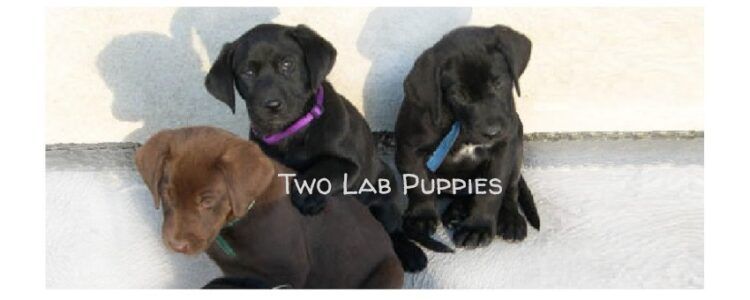
This is a story about two Lab puppies that were very special dogs.
The best place to start is at the beginning…
I heard about a daughter of River Oaks Way-Da-Go Rocky that was for sale. She was field-bred, but looked like a classic Lab with a broad head, good angles and plenty of bone.
It was a no-brainer. I had to bring her home.
Dee was wonderful in the house – clean, quiet and she fit right in. In the field, she was dynamite. She was focused, fast and so easy to run.
She was the first dog I ran in hunt tests. She started in four tests and titled in four tests. In hindsight I should have run her in the next level as well.
But then she came in season and I bred her to my very talented chocolate boy, Chip.
I was hoping for a chocolate female puppy.
The birth of two Lab puppies and their siblings…
The first four puppies came out every 30 minutes like they were on a timer – boy – boy – boy – boy.
Then we waited. And waited. An hour went by. Two hours. Three hours.
It was so long since the last puppy and there were no more signs of contractions. I thought Dee must have finished whelping so I started putting away all the whelping supplies.
I was so sad not to get my chocolate girl.
A happy surprise…
Then FOUR HOURS after the last puppy was born, she had another puppy.
A boy. Jeez Louise!
Shortly after that she had two more puppies – a black girl and a chocolate girl!
Meeting my heart dog…
The story doesn’t end there though. I was so happy to get the chocolate girl I’d wished for, but there was another puppy. Every time I cleaned the whelping pen or interacted with the puppies the black girl paid attention to me. She had fabulous eye contact!
The more I got to know her, the more I fell in love.
She was Arwen. My heart dog.
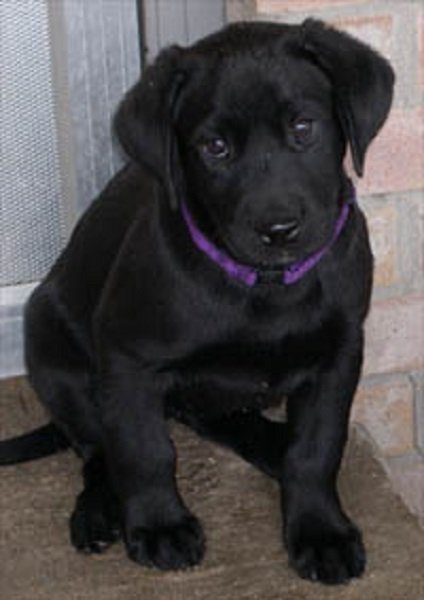
The story doesn’t end there however…
The first born boy became my husband’s favorite. I think he liked him for the white star on his chest.
He promised he would train him and take him to work with him. It didn’t happen so I put the puppy up for sale. I got several good offers for him, but I couldn’t do it. I’d fallen in love with him too.
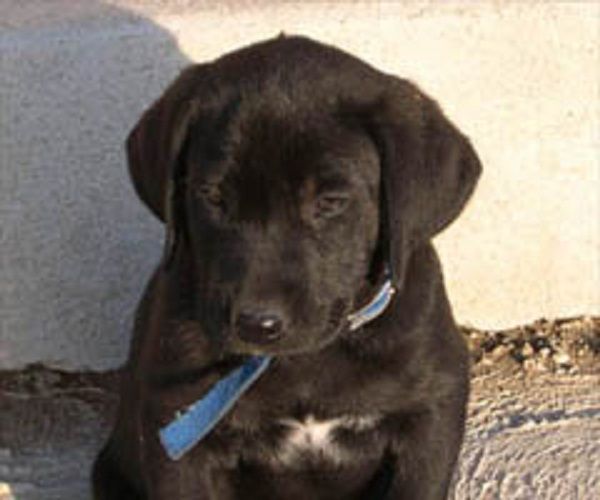
He was Tory. Another heart dog.
The two Lab puppies grew up…
Tory grew to be a big, impressive male with a deep bark. Often he would sit in the car watching as I went in a store. When he saw me come out, he would woof. Just once and just loud enough for me to hear.
He earned four Rally titles in 29 straight runs with a perfect score and several placements. He enjoyed competing.
Tory also competed in hunt tests – both AKC and HRC. He was on the verge of completing his Hunting Retriever Championship title when he collapsed. I rushed him to the veterinarian who said his heart was failing. She gave him a few weeks to live.
He made it nearly six more months and didn’t show any signs of a heart problem. To be safe, he didn’t run in any more field events and lived a happy, but quiet, life.
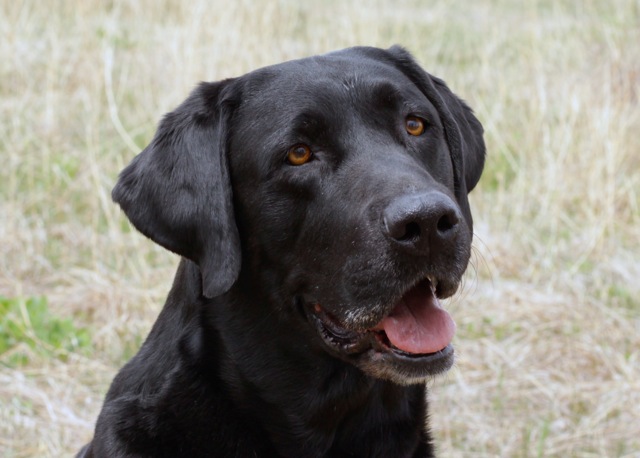
Arwen was smaller than her brother, but she was the alpha. Tory was the enforcer and kept the other dogs in line. One day he thought Arwen did something wrong and he trotted over to set her straight. She just turned and gave him “the look.” It was comical to see that big dog do a reining horse slide stop and then tip-toe away from her.
She was multi-talented and competed successfully in several venues – hunt tests (AKC and UKC), obedience, Rally and Barn Hunt. In addition to titles, she also earned special awards. At the Labrador Retriever Club national specialty, she received the Dog For All Reasons award. She was the third dog to earn the LRC’s Versatile Producer of Merit award. Arwen also received awards such as a Multi-Purpose Retriever and a Retriever Achiever.
However her most important roles were as my shadow, my sidekick, my confidant, and my friend.

Not an ending…
These two Lab puppies and their dad, Chip, were my Musketeers, my constant companions and my teachers. Anything I asked, they tried.
Someday there will be a joyful reunion at the Rainbow Bridge.
Two Lab puppies:
HRCH UH Justamere Arwen CD SH RE RATN CGC CC
HR UH Justamere Aviator CD SH RAE CGC CC
Sire:
HRCH Justamere Chocolate Chip CD TDX SH RAE CGC
Dam:
Knight’s Tail Dehlia JH
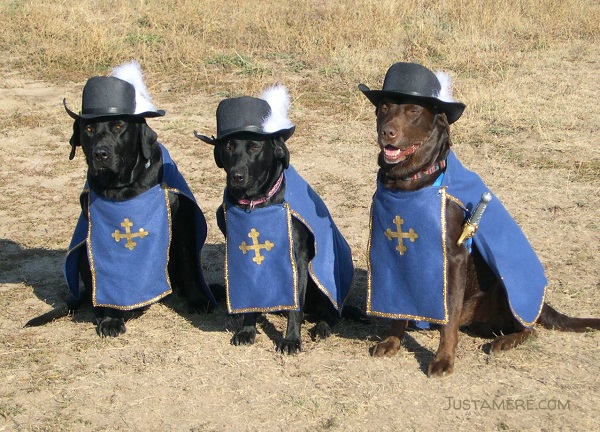
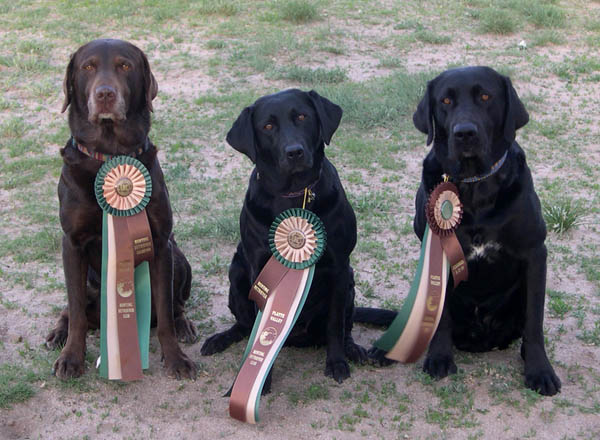
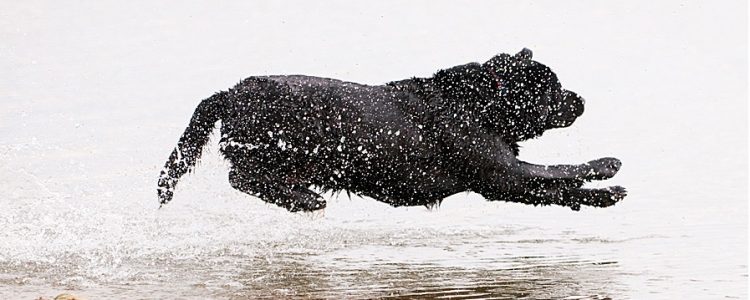
The last local AKC retriever hunting test of the season is in the books.
Beautiful property with fabulous water, good weather (yes, a bit hot) and lots of great dogs and their handlers.
There was even a chocolate Lab I’ve got my eye on!
My co-judge, Jeff Baldwin, drove all the way from Utah to bake in the high plains sun. Wyoming kindly sent us some of their wind every afternoon.
We designed the Senior hunting test on Friday. Jeff judged Junior on Saturday while I worked at Master. On Sunday we judged Senior together.
It was a long weekend.
What did we set up and why?
The requirements for an AKC Senior hunt test are:
- a double retrieve on land
- a double retrieve on water
- a land blind
- a water blind
- an honor
Then we had to throw in a live flyer, a walk-up, a diversion shot and multiple decoys. Plus adding some other trappings to simulate a real bird hunt. (See the Glossary below.)
We chose to start off with the land series in the morning. Having the water series afterward gave the dogs a chance to cool off in the afternoon heat.
The first two photos were taken from the “line” – the spot where handlers bring their dogs to start the test.
To begin, we called for a “handler’s meeting” to introduce ourselves and describe the test. Often there are several questions.
Next we ran a “test dog” (a dog who was not in contention). He ran the test to make sure everything worked as planned and to show the handlers the test set up.
Of course, the dogs in contention didn’t get to watch!
After completing the two marks successfully, the test dog and handler moved to the “honor box” which is a spot nearby where the dog can watch the next dog work.
This is often a challenge for dogs at this level.
Having just completed two retrieves the honor dog is often excited, but must be “steady” (remain quietly in place) off leash. He must watch the next dog retrieve at least the first mark.
Starting the Senior Hunting Test
Next the handlers lined up in “holding blinds” (fabric set up to block the dog’s view of the test). AKC suggests dogs run in catalog order. However some handlers run dogs in other stakes and may need to run out of order.
When we were ready, we asked the handler in the final holding blind for the dog’s number. Leashes come off before leaving that holding blind to run the test.
To simulate a real hunt, handlers had to shoulder and point a shotgun as each bird was thrown. The handler’s gun is usually disabled for safety, but must be treated as a loaded gun. That applies even if the “gun” is only a wooden cutout.
When the handler signaled they were ready, we had bird tech #1 throw the first bird. This was a duck from a winger hidden behind a clump of trees near the left side of the field.

The bird went from right to left and landed in some rather sparse cover, about 70 yards away. Just before throwing the bird, the bird tech blew a duck call and shot a blank to get the dog’s attention. There were also multiple goose decoys the dogs had to run through to get to the bird.
Many dogs wanted to retrieve right away, but they had to be steady and wait for the second bird to be thrown – a “double retrieve.” This bird was a “flyer” (a live bird that was thrown and then shot in the air) which is very exciting for the dogs. All the other birds were already dead before being thrown.
The second bird
Bird #2 came out of a winger hidden behind the berm that ran parallel to and behind the line of trees. Flyers rarely land in exactly the same place so the distance to the bird varied, but averaged about 60 yards.

Because of the excitement caused by a live flyer, several dogs “broke” (ran to retrieve it before the handler’s command). Dogs that retrieved the bird without being released were disqualified. However if the handler was able to stop the dog quickly (within about 15 feet) they were allowed to continue. They were penalized for a “controlled break.”
Some dogs didn’t break, but moved a little bit towards the birds. This is called a “creep” and is penalized, but less than for a controlled break. Dogs moving beyond the length of the gun barrel had to return to heel before they could retrieve.
After both birds were down, we had the handler send their dog. They could pick up the birds in any order, but usually chose to get the last bird down first. This is especially so when that bird is a flyer!
After delivering one of the birds “to hand” they were sent to retrieve the other bird. When the working dog was sent on the first retrieve, we dismissed the honor dog.
If the working dog did a passable job on the double retrieve, they next had a “blind retrieve.”
Problems
Sometimes dogs forgot where a bird landed and had a big hunt or ran towards where they already found a bird.
Returning to an old fall and switching are both disqualifications. They are similar faults. “Returning to an old fall” is going back to where they already retrieved a bird. “Switching” is abandoning a hunt for one bird to go to a different bird.
When a dog hunted too far away from the bird or started toward the other bird, handlers blew their whistle. At that point the dog was handled to the bird using the same technique as a “blind retrieve.” This means directing the dog to a bird he didn’t see fall.
The blind retrieve
We “planted the blind” (placed a bird in the field when the dog wasn’t watching) near a bush 50 yards away.
To get to the blind, the dog had to pass some larger bushes and diagonally cross a dirt track. The location was to the left of bird #1 and slightly out of the left side of the first photo.
For a passing score, the handlers had to “challenge the blind.” This means keeping their dogs close to a direct line to the blind. Dogs should not run all around in hopes that he would eventually find it on his own.
Dogs were penalized if they didn’t:
- stop on the whistle
- take the correct cast
- maintain the new direction for at least a few yards.
Senior dogs are at an intermediate level of training and still learning so each penalty was only a minor deduction.
Thirty-one dogs did a double retrieve, blind retrieve and an honor. Twenty-nine competed plus a test dog (honored the first dog) and a bye dog (retrieved while the last dog honored).
Dogs that had a passing score on land were “called back” to run the water series.
The water series
We moved a 1/4 mile south to a spit of land. There was a water channel on the left side and open water on the right.
This series included a double retrieve and a blind retrieve with a walk-up and a diversion shot. No honor, no live birds.
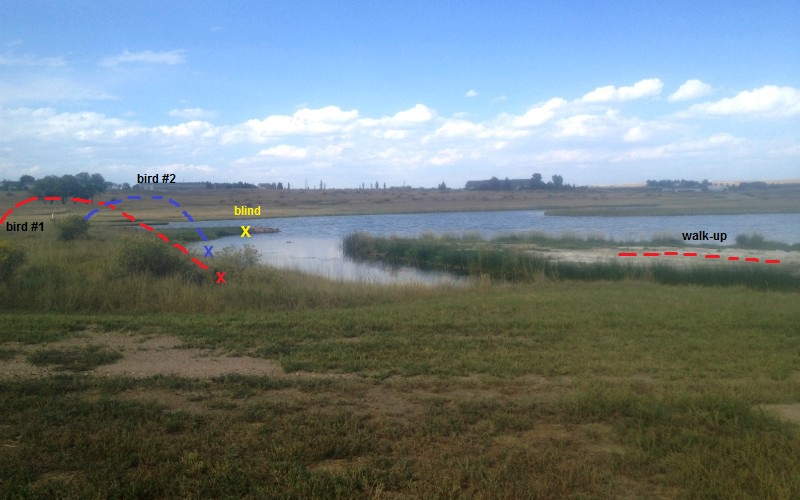
To start, the handler walked down the spit with their dog at heel. When they got to a certain point, there was a gun shot and a bird was hand thrown. It landed in grass about 8-10 inches tall and about 4-6 feet from the water’s edge.
The second bird came out slightly left to right, with another gun shot. It landed with a splash about half way down the channel. Both bird techs were hidden behind tall bushes.
The dogs could retrieve the birds in any order. When they were returning with bird #1, there was a diversion shot to set up the blind.
Most dogs did fairly well to great on the water double retrieve. There were a few that needed to be handled to one of the birds. A few dogs needed to be handled to the memory bird on land and one of the birds on water.
The blind was across to another spit of land and was placed just out of the water.
There was some suction to old falls and to a bit of land poking out of the water. Otherwise this was a straight forward blind. All the dogs who attempted it did fine.
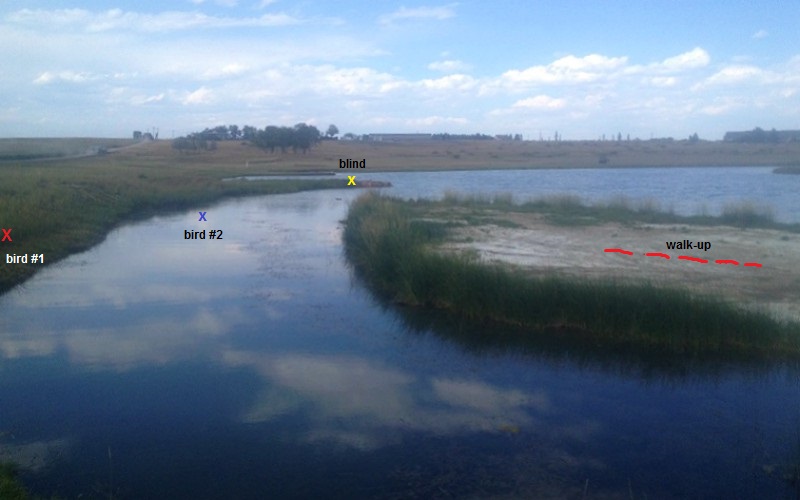
Summing up…
Our goal was to make both series as hunt-like as possible while staying within AKC’s rules for a Senior hunting test.
We also wanted the handlers and dogs to enjoy it and to make sure everyone was safe.
Some dogs did very well overall. Other dogs did better on one series or the other. And some dogs had enough trouble that we couldn’t give them a ribbon this time.
I’m grateful to the Mile High Golden Retriever Club for asking me to judge. To the owners and handlers who entered their dogs. To all the helpers for handling the myriad of jobs. And to my co-judge who made it so easy, it felt like we’ve been working together for years.
By the way, all of my dogs got to experience that great water.
The adult dogs loved it. The younger ones quickly learned that the end of grass doesn’t always mean there’s a gentle slope into shallow water. However they did get to practice new swimming skills.
And the drive home was rather quiet – except for some snoring coming from the back.
Update: I’m sad to say Jeff has left the bonds of Earth. I hope he’s been reunited with family and friends and, of course, his favorite dogs. We miss him greatly.
Glossary for a Senior hunt test
BLIND RETRIEVE – The dog is sent to retrieve a bird that it did not see fall. The dog is expected to take hand, voice and whistle signals to direct it to the bird.
DIVERSION – Either a shot or a fall designed to divert the dog’s attention from the task at hand.
DOUBLE – Two birds to retrieve.
HONOR – Dog to sit quietly off-leash on or near the line while another dog retrieves.
MARK – A retrieve that the dog has seen fall.
MEMORY BIRD – First bird the dog sees thrown/shot on a multiple mark. Usually the last retrieved.
STEADY – Dog does not leave assigned spot until instructed by the handler to retrieve.
WALK-UP – Bird is thrown while handler and dog are walking with the dog at heel, much like jump shooting.
By: Rich Carpenter
You can see the entire glossary on the Platte Valley HRC’s website.
Originally published September 22, 2018.
You might also like –
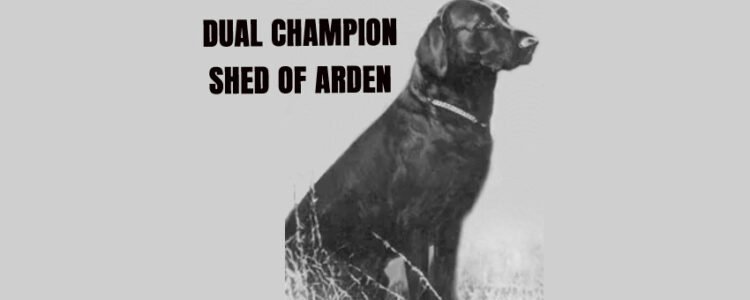
“Shed of Arden’s qualities were of the highest: he epitomized an ideal.
…By those who are knowledgeable, he was considered to have embodied the greatest qualities a Retriever can possess in equal parts: looks, performance, and the priceless gift to transmit these from generation to generation.”
~ Helen Warwick, Lockerbie Labradors
Shed of Arden’s story
3xNFC CFC DUAL CH Shed of Arden is one of the best-known Labrador Retrievers in history, but what do we know about him and his family?
Shed was born March 26, 1939, and bred by William Averell Harriman who owned Arden kennels. Paul Bakewell III of Deer Creek Kennels bought Shed as a young dog.
There’s a story that his siblings were all named for fish and that he was supposed to be Shad of Arden. Due to a clerical error he became Shed instead.
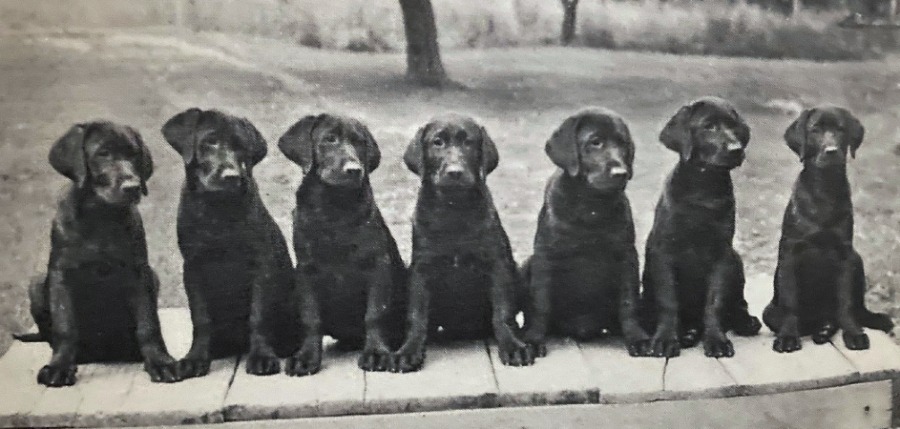
The Arden ‘fish’ litter, including Shed, Bass, Marlin, Trout.
Competition
Show competition
Although Shed often competed in the show ring and field at the same time, he started his career in the show ring. At 14 months old he won Winners Dog and Best of Winners for a 5-point major at the Labrador Retriever Club’s specialty show in 1940. His older brother, CH Earlsmoor Moor of Arden, won Best in Specialty at that show. A week later the brothers repeated their wins at another show with another major for Shed.
He finished his show championship 15 months later with two Best of Breed wins and a Group 4th.
Field Competition
Retriever field trials in America were still in their infancy when Shed was born. It was only nine years since his uncle, NFC Blind of Arden, won the first field trial.
Shed started his field career with a Derby second at 20 months, still owned by his breeder.
The next year he started earning points in field competition. By the fall of 1942, he had finished his field championship to become a dual champion. He also qualified for the National Retriever Championship.
National Championship 1942
As a 3-year-old, Shed won his first National Championship. He was handled by Lt. Bakewell who was on leave from the Navy Air Corps.
Madison, Wisconsin hosted the National on December 4-6, 1942. The weather was cold. “The Yahara River and adjoining marshes which ordinarily afforded everything desired for water tests were frozen solid…. This necessitated moving the water tests to the University of Wisconsin property along the shores of Lake Mendota. Heavy ice floes made it dangerous for dogs to get into the water. Several refused to enter, others only after repeated commands.” 1
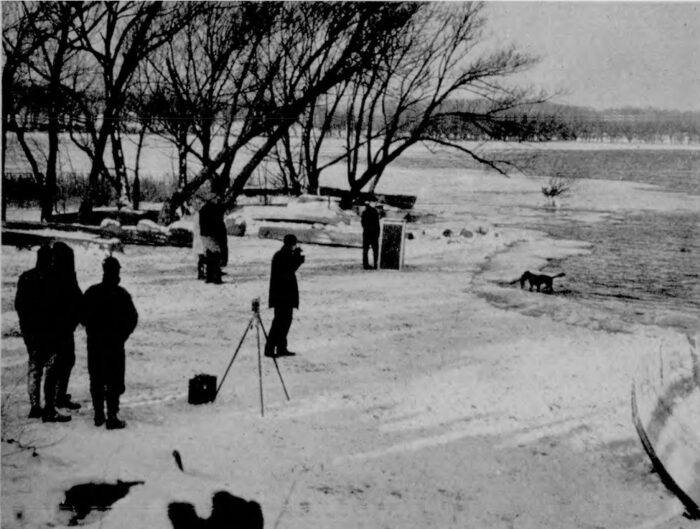
Icy conditions on Lake Mendota. Photo courtesy American Kennel Gazette.
“The weather was bitter and difficult on the great gallery, but it was weather to be expected in the final week of the Wisconsin duck hunting season and no dog who could not meet these conditions could rightfully aspire to the national title.” 2
“To win, Shed had to show supreme ability to bound over frozen hummocks in quest of pheasants and to break sheets of ice in swimming after ducks. In fact, it is hard to imagine more trying conditions than those which the dogs, their handlers and the gallery faced during the three days of the stake. The thermometer was never far from zero, and frequently was below that mark….” 3
Eighteen dogs started, but only five finished, including two owned by Bakewell – Shed and FC Stilrovin Super Speed. The other finishers were FC Hiwood Mike, Patricia of Roedare, and Seaborne’s Black Prince.
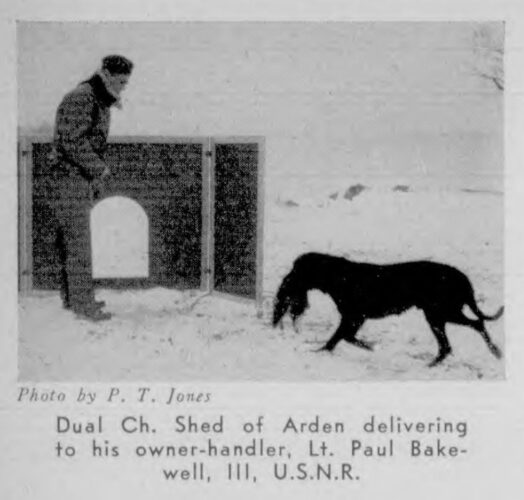
Shed of Arden delivering a bird. Photo courtesy American Kennel Gazette.
“Throughout the meeting Shed did everything asked of him, and did it brilliantly. Probably the thing that most pleased the gallery was the way that willingness was demonstrated when, in the final water test, he never hesitated a minute in crashing his way out through brittle ice…” 4
National Championship 1943
Shed won the National Championship again the next year. He was handled by Clifford H. Wallace because Lt. Bakewell was on active duty.
Bourbon, Missouri hosted the stake on December 3-5, 1943. Twenty dogs started, of those 15 were Labs and five were Goldens. It took two extra series to determine the winner between two dogs – Shed and a Golden Retriever named FC Stilrovin Super Speed. Both dogs were owned by Lt. Bakewell.
Cotton Pershall trained Shed until until it was time to join the Army. At that point, Clifford Wallace took over and guided Shed through the grueling tests in Missouri.
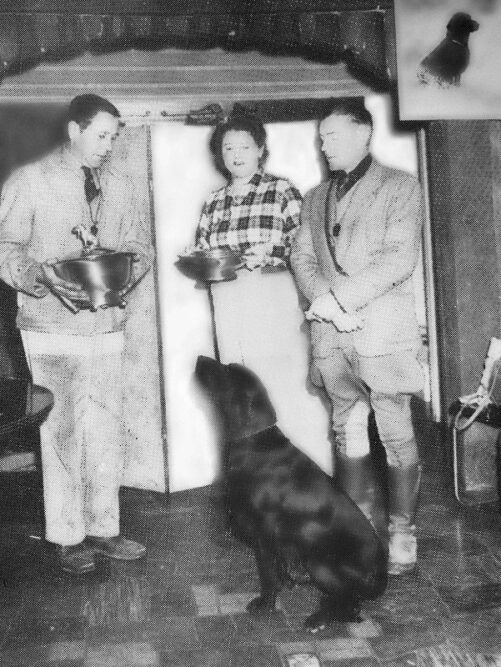
Mrs. Bakewell with Shed and handler C.H. Wallace. Presenting the trophy was M.B. Wallace Jr, trail chairman. Photo courtesy American Kennel Gazette.
Shed didn’t compete in the 1944 National. However, he did travel to Vancouver, British Columbia in October where he finished his Canadian Field Championship.
National Championship 1945
World War II ended in 1945 after Germany surrendered in May and Japan surrendered in September. That November Shed and Bakewell were back to compete in the National Championship. This time it was held at Shelter Island, Long Island, New York, which meant a daily ferry ride from Riverhead. The stake was held on November 30-December 2, 1945.
The first day brought blinding snow and sleet which limited the day to only one series. The second day was cold and windy with high tides and northerly winds. The judges ran land tests in the morning and water tests as the tide ebbed. Despite the conditions, only six dogs were dropped.
Although Shed was a finalist, the judges awarded the win to Black Magic of Audlon.
National Championship 1946
Shed was now seven-years-old, but he continued competing at trials around the country. At a trial in Oregon he had a 300-yard blind retrieve across the tip of a lake for a shackled duck planted several yards off the shore. He was one of only six dogs to complete the series.
In the fall of 1946, Shed reclaimed his crown and is the only three-time winner of the National Championship. It was held on December 6-8. The grounds were good at Crab Orchard Lake, Herrin, Illinois, as was the weather. This is a coal mining area, and the mines were on strike at the time of the National. “… the gallery was augmented by many hundred miners who came to see the event. Some estimated the gallery at 10,000. Traffic presented a bit of a problem.” 5
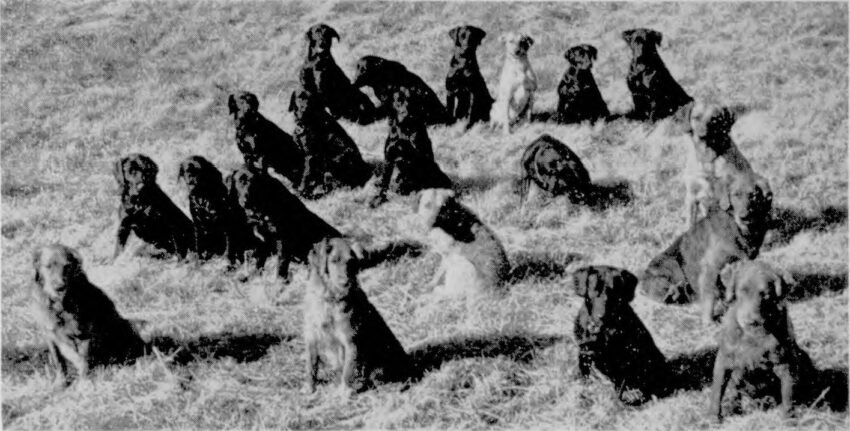
The 20 dogs entered in the 1946 National Championship Stake. Photo courtesy American Kennel Gazette.
Twenty dogs started the stake and eight finished.
In the final series, Shed faced off against three tough competitors. They were his kennel mate, Dual Champion Little Pierre of Deer Creek, plus FC Scoronine of Deer Creek, and a Golden retriever named Stilrovin Nitro Express.
“Scoronine led the field until the last day, then refused to plunge into the 45° water. Now it was Shed’s turn.
“In the toughest test, he had to find two dead ducks which had been planted among the rushes across a 150-foot-wide bay. Shed waited calmly at the water’s edge until he got the signal from Bakewell. Then he plunged bravely into chilly Crab Orchard Lake, but not with his old zip.
“… One-third of the way across, Shed’s black head turned at a whistle from Bakewell to get directions. He entered the cattails just six feet from where the mallard was hidden, sniffed for a second, found his bird. A few minutes later, Shed did it again, and won his third U.S. championship.” 6
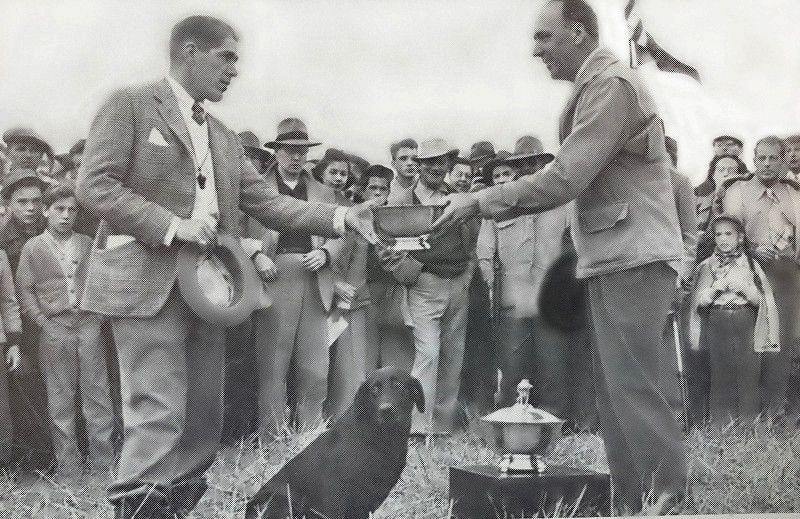
Paul Bakewell received the championship trophy for Shed’s third national championship win.
National Championship 1947
Shed ran the National Championship one more time. The 1947 National was again held at Crab Orchard Lake, Herrin, Illinois. The weather was good with only occasional light rain. Twenty one dogs started, but only four dogs finished. These dogs completed the tenth – and the eleventh – and the twelfth series in an effort to determine the winner. The final series was completed in near darkness.
These dogs were:
FC Black Panther, owned by CW Carlson
FC Black Roland of Koshkonong, owned by Wesley Jung
FC Bracken’s Sweep, owned by DE Pomeroy
DUAL CH & 1942 , 1943, 1946 NATL CH Shed of Arden, owned by Paul Bakewell
Bracken’s Sweep, handled by TW “Cotton” Pershall, was crowned the winner.
Shed’s Family
| CH Raffles of Earlsmoor | Thatch of Whitmore CCW | Eng DUAL CH Titus of Whitmore |
| Tee of Whitmore | ||
| Task of Whitmore CCW | Toi of Whitmore FTW | |
| Eng CH Teazle of Whitmore | ||
| FC Decoy of Arden | Odds On FTW | The Favorite FTW |
| Jest | ||
| Peggy of Shipton FTW | Ronald of Candahar | |
| Gehta of Sigeforda |
His parents
Shed’s sire, Raffles, was Dr. Samuel Milbank’s first Labrador although dogs were always part of his life. His father, Dr. Milbank, Sr., bred Chesapeake Bay Retrievers and terriers.
A Scottish surgeon started the junior Dr. Milbank into Labradors when he found and shipped Raffles to him. According to Helen Warwick in The Complete Labrador Retriever, importing Raffles “started a collaboration of Dr. Milbank and W.A. Harriman that molded the fortunes of the Arden kennel, setting a precedent for quality that has never been equaled by any other Labrador Kennel in America.”
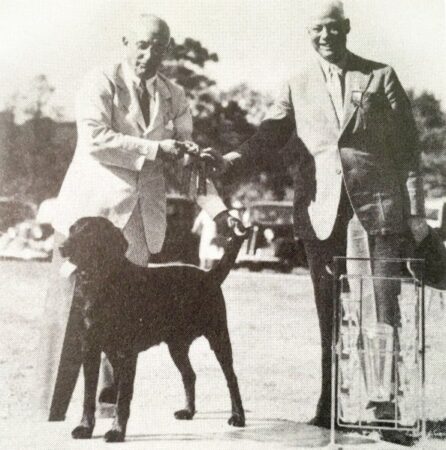
Show champion Raffles of Earlsmoor
Decoy, Shed’s mother, was the second Lab to earn a field trial championship in America. Her full brother, Blind of Arden was the first to earn a field trial championship and also won the first US retriever field stake in 1938.
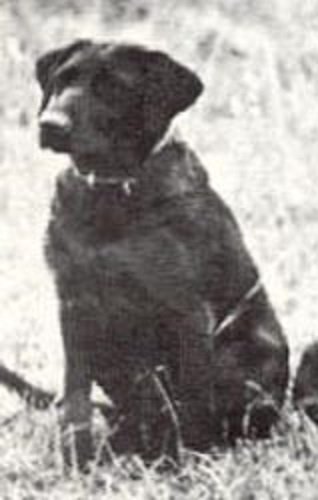
Field champion Decoy of Arden
Shed descends multiple times from well-known Labs such as English field trial champions Flapper and Peter of Faskally plus the first dual champion Banchory Bolo.
His siblings
Some of Shed’s full siblings included:
- CH Earlsmoor Moor of Arden
- CH Earlsmoor Marlin of Arden
- DUAL CH Gorse of Arden
- DUAL CH Braes of Arden
- CH Bass of Arden
Half siblings included:
- FC Gun of Arden
– Grandsire of 2xNFC Spirit Lake Duke and great-grandsire of DUAL CH CFC Ridgewood Playboy and CH Whygin Gentle Julia Of Avec - Marvadel Cinders
– Dam of Can DUAL CH Coastal Charger of Deer Creek and NFC AFC Marvadel Black Gum
His titled offspring include:
CNFC FC AFC Ardyn’s Ace of Merwalfin
FC AFC Bigstone Bandit
CFC Chanbar Jigaboo ***
CH Chukker of Bonniehurst
NFC AFC Creole Sister
FC Dacity Bill
CH Dauntless of Deer Creek
CH Deer Creek Black Ace
FC Firelei’s Hornet
FC CFC Jibodad Gypsy
CFC Nelson’s Black Prince
FC Pickpocket for Deer Creek
CH Snikeb’s Cookie
CH Trixie’s Black Cargo ***
CH Wardwyn Jackpot
Shed’s descendants at Justamere Ranch:
Chip descends multiple times from Shed. Those bloodlines include:
Dual and field champions –
NFC Dual CH CFC Bracken’s Sweep
Dual CH Grangemead Precocious
CFC Chuck of Bracken
FC Dacity Bill
FC Freehaven Muscles
FC Gilmore’s Peggy
FC Shoremeadow Tidewater
FC AFC Tar Baby of Hilly Hill
Dee also descends multiple times from Shed. Those bloodlines include:
Dual champions –
Dual CH AFC Alpine Cherokee Rocket
Dual CH Cherokee Buck
Dual CH Grangemead Precocious
Dual CH Ridgewood Playboy
Can Dual CH Coastal Charger of Deer Creek
Can Dual CH Dart of Netley Creek
Field champions –
FC AFC Air Express
FC Beautywood’s Carbon Copy
CNFC FC AFC Belle of Zenith
FC AFC Bigstone Bandit
NAFC FC Bracken’s High Flyer
FC AFC Canis Major’s River Bear
NFC AFC CFC Cork of Oakwood Lane
FC AFC Cougar’s Rocket
CFC Crevamoy Iron Duke
2xNAFC FC Dee’s Dandy Dude
FC Deer Creek’s Bewise
2xNFC CNFC AFC Del-Tone Colvin
NAFC FC Dude’s Double or Nothin’
FC Firelei’s Hornet
FC Freehaven Muscles
FC Gilmore’s Peggy
FC AFC Ginger’s Choc August
FC AFC CFC Grady’s Shady Ladee
NAFC FC CFC Guy’s Bitterroot Lucky
AFC Jilly Girl
FC AFC Les Coup De Grace TD
FC Luka of Casey’s Rocket
FC Martens Mister Nifty
FC AFC Mon Tour De Force
FC Mueller’s Stormy Canada
FC Nelgard’s Counter Point
CFC Nelson’s Black Prince
FC AFC Paha-Sapa Chief II
AFC Penny Girl
FC AFC Raider’s Piper Cub
FC AFC Rip’s Bingo
2xNAFC 3x CNFC FC River Oaks Corky
NAFC FC River Oaks Rascal
FC AFC River Oaks Way-Da-Go Rocky
FC Roy’s Rowdy
FC AFC Serrana Sootana of Genesee
FC AFC Shed’s Prince of Garfield
NFC 2xNAFC Super Chief
FC AFC Tar Baby of Holly Hill
2xCNFC AFC Tar Baby’s Little Sweet Stuff
FC AFC CFC Trieven Thunderhead
FC AFC CFC Triple Echo
FC AFC Trumarc’s Raider
AFC Westwinds Shadow of Hope
2x NFC Whygin Cork’s Coot
CNFC FC AFC Yankee Clipper of Reo Raj
FC Zipper Dee Doo
Show champions –
CH Dauntless of Deer Creek
CH Rupert Dahomey
CH Whygin Poppitt
CH Woodcroft Daisy
Conclusion
During his career, Shed earned both US and Canadian Field Championships and a US show championship which qualified him as a DUAL champion. He also ran in five national field championships – winning three times and finishing as a finalist the other two times. At one point his owner turned down an offer to buy him for $10,000 (equivalent of about $150,000 today).
Sometimes the descriptions of field trials from years ago sound more like hunt tests. Don’t be fooled. The tests were real hunting scenarios. On the East Coast, birds were often thrown from a boat well out in the mouth of a bay. An outgoing tide could carry that bird out even farther. Trials were held even if the temperature was below zero, but jumping into frigid water and breaking ice was one of Shed’s specialties. A trial he won as a seven-year-old, included “a 300-yard blind retrieve across the eastern tip of the lake for a shackled duck that was planted several yards from the opposite shore.” 7
He was a good ‘un.
3xNational Field Champion, Canadian Field Champion, Dual Champion Shed of Arden
Whelped: March 26, 1939
Owner: Lt. Paul Bakewell III, Deer Creek Kennel
Breeder: W. Averill Harriman, Arden Kennel
Registration: A-330767
Abbreviations:
CH – Show champion
FC – Field trial champion
NFC – National field trial champion
CCW – English Conformation Certificate winner (not a title)
FTW – English Field trial winner (not a title)
CFC – Canadian field champion
Notes:
[1] The National Retriever Field Trial Club, 1941-1960, 62.
[2] “Victory Well Earned”, New York Times December 12, 1942
[3] “Dual Ch. Shed of Arden Wins Retriever Championship”, American Kennel Gazette, January 1943, 65.
[4] Ibid
[5] The National Retriever Field Club, 1941-1960, 79.
[6] “Sport: An Old Dog’s Day”, Time magazine, December 23, 1946
[7] “Shed of Arden Wins Oregon Open All-Age”, American Kennel Gazette, June 1946, 92.
We had a great weekend – despite the heat and wind near Boone, CO at an HRC hunt test. Arwen passed a tough Finished test, Tory passed his third Seasoned test, and Jazzy got to run two Started tests and passed both!
Finished test
The Finished test started with a wide-open triple retrieve and a diversion as the dog returned with the last bird. Although it was called a dove hunt, we rarely use any birds except ducks because they hold up better. I’ve seen pigeons or chukar used on rare occasions, but only for the land retrieves.
After the triple we did a blind retrieve with lots of suction to the nearby dike and to the old falls.
Arwen did fabulously in this series! And I, crack shot that I am, knocked down every bird I shot at.*
Finished, Part two
When all the dogs completed the “dove hunt” land series we moved to the water series with ducks. This series was a mind-bender trying to remember which bird is shot at by which handler and which dog got to retrieve.
It started off with a buddy on the honor bucket as Arwen and I walked down the muddy path. On the way, a duck came sailing in from the left. Both handlers shot at it, but remembering not to shoot in the direction of the other handler! The honor dog picked up that bird while the working dog (Arwen) had to watch.
Once we got settled on a bucket, a duck came in over our right shoulder. Followed quickly by another duck that came in from the left. Both handlers shot at the birds. Arwen picked up the left bird after a long swim, then rooted the right bird out of the reeds.
Somehow with all that “shooting” we put down another bird way off to the left. This set up a blind retrieve. The line to the bird was just off the beach with suction to the shore and to the old fall. With a couple whistles to keep a tight line, Arwen picked up that bird.
Time for a new “hunting buddy.” As he came down the path with his dog, we moved to the honor bucket, but this dog was amped! When he came into sight Arwen must have figured she’d need a head start to beat him to HER birds. She took a few steps toward the water during the double, but luckily decided not to go any further. Good dog!
Thanks to judges Erik Brekke and Tim Boies for a fun test!
Seasoned test
Seasoned is a pretty big step up from Started. There are five tests: a walk-up, double land mark, land blind, double water mark, and a water blind. There’s also a diversion bird.
Tory did well on the water blind, but needed a handle on the water memory bird (as did most dogs). The walk-up was along the tree line, followed by a double mark with a diversion bird. Then a walk back to the first side of the trees for the land blind. Tory did great on all of it.
The hardest part was the long wait to get through the five tests for all of the dogs.
Thanks to judges Faron Eddy and Bob Moreschini!
Started test
The Started test began on the very muddy shore of a large pond. My friend was one of the first handlers to run the test and it was her first test. She did great, except for not letting go of her dog’s collar in time.
Boots stuck in the mud and her dog leaping forward led to a full body splat in the mud. After cleaning up, she went to try again only to be told by a judge that her dog failed. As a judge myself, I disagree with that judge’s decision. Started often has beginning level dogs and inexperienced handlers. For the sport to survive, we need to encourage new people. I applaud my friend’s courage to try again and to continue running her dog to complete his Started title.
My dog, Jazzy, did great on the water marks, although I teetered a bit in the mud. She also did great on the land marks, but was a little sticky on one bird. However I wasn’t too concerned as it was the first time she’d retrieved a pigeon. Before this test she had only retrieved bumpers and ducks.
*Note: We don’t use live ammunition in HRC hunt tests. There is an exception for Upland tests which uses live birds. Even in that case only designated shooters have live ammo. Handlers have blanks, but must treat all guns as if they’re loaded.
Conclusion
If you haven’t been to an HRC hunt test and would like to learn more, check out the Hunting Retriever Club’s website. There is also information about local clubs. Check if there’s a club near you and see if you can join them on a training day.
Another option is to search for hunt test videos on YouTube. There are quite a few to choose from, plus more videos about AKC hunt tests.
Originally published May 25, 2010.
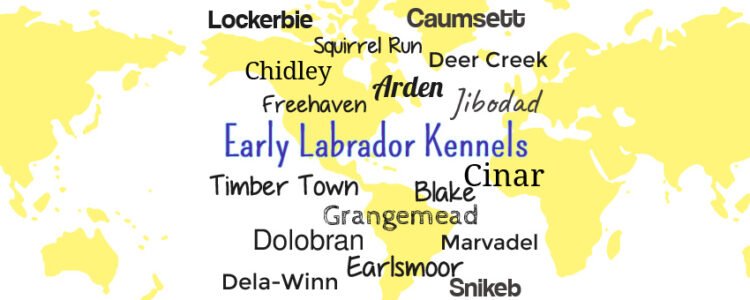
The Labrador Retriever was reintroduced to America in the late 1920s and early 1930s. Some early Labrador kennels helped the breed become popular. These included:
- Jay Carlisle, Wingan
- Hon. Averell Harriman, Arden
- Franklin Lord, Blake
- Marshall Field, Caumsett
- Paul Bakewell III, Deer Creek
- Dr Samuel Milbank, Earlsmoor
- Mr and Mrs Frederick, Timber Town
Below is an alphabetical list of early kennels in America.
Early Labrador Kennels
| Kennel Name | Owner | Location |
|---|---|---|
| Aldenholme | Mrs Barbara Barty-King | Massachusetts |
| Alvaleigh | JHL Fisher, Mrs Alva S Robinson | Maryland |
| Arden | Hon. Averell Harriman | New York |
| Ashur | Mrs Johnson Smith | New York |
| Bankhurst | Dr George D Patton | Colorado |
| Barnegat | Alfred E Johnson Jr | New Jersey |
| Barn Hill | Richard B Ross | New York |
| Bay Shore | Mrs Russell G Merriman | Vermont |
| Bellota | Mr and Mrs Richard Reeve | Arizona |
| Bergee | Mr and Mrs MJ Leclerc | Illinois |
| Big Talk | EP Landwehr | Michigan |
| Bijiminy | Mr and Mrs JB Deuel | California |
| Black Point | Mr and Mrs Daniel E Pomeroy | New Jersey |
| Blake | Franklin B Lord | New York |
| Bluefield | Hiram BD Blauvelt | New Jersey |
| Broadfen | Mr and Mrs Gaylord Donnelley | Illinois |
| Caniston | Mrs John Griswold | Pennsylvania |
| Casa Audlon | Mr and Mrs MB Wallace Jr | Missouri |
| Caumsett | Marshall Field | New York |
| Cheam | Col Andrew M Naismith | British Columbia |
| Chidley | Mrs Curtis Read | New York |
| Cinar | E Roland Harriman | New York |
| Coaltown | Robert D Cowen | Ohio |
| Cutbank | Mrs Curtis Munson | District of Columbia |
| Dairy Hill | Mr and Mrs AA Jones | California |
| Deer Creek | Mr and Mrs Paul Bakewell III | Missouri |
| Dela-Winn | Mr and Mrs Harley A Butler | Wisconsin |
| Del Monte Sol | Mrs LT Konopak | New Mexico |
| Dolobran | Clement A Griscom III | Pennsylvania |
| Ducklore | Arthur C Storz | Nebraska |
| Duckwind | A Wells Wilbor | Minnesota |
| Dunottar | Mr and Mrs Henry S Morgan | New York |
| Earlsmoor | Dr and Mrs Samuel Milbank | New York |
| Elsted | Edwin M Bulkley Jr | Connecticut |
| Fairmount | Karl F Bruch | Ohio |
| Freehaven | James L Free | California |
| Giralda Farms | Mrs M Hartley Dodge | New Jersey |
| Glennspey | Cpt John L Graham | New Jersey |
| Grangemead | Mr and Mrs TW Merritt | Illinois |
| Greeymar | Stephen M Greey | Toronto |
| Harpersbrook Shadow | Palmer K Leberman | New York |
| Holly Bank | Mr and Mrs CL Roberts | Pennsylvania |
| How-Hi | Mr and Mrs Howes Burton | New York |
| Hurricane | Mr and Mrs Wm L Austin | New York |
| Inkstone | Mrs Robert E Smith Jr | California |
| Invail | Mr and Mrs CV Brokaw Jr | New York |
| Jibodad | James W Bryan Jr | Washington |
| Kidwell | John McKenney | Maryland |
| Kilsyth | Mrs Gerald M Livingston | New York |
| Labappy | Dr George D Massey | Oregon |
| Lallinden | Mr and Mrs Albert P Loening | New York |
| Land Fall | Rear-Adm and Mrs CL Andrews Jr | Rhode Island |
| Larchmont | Dr HBK Willis | California |
| Latch-up | Arthur M Lewis | New York |
| Lockerbie | Mr and Mrs James Warwick | New Jersey |
| Lonely Acres | Roland H Simmon | New York |
| Macopin | Mr and Mrs George Murnane | New York |
| Mae-Don | Mr and Mrs Don P Smith | California |
| Manzanal | Edward R Spaulding | California |
| Marvadel | Mr and Mrs J Gould Remick | New York |
| Maryland | Mrs Theodore Gould | Maryland |
| Mill Cove | Arthur Gwynne | New York |
| Money Bogge | DeWitt Peterkin | New York |
| Moongate | HVP Lewis | Toronto |
| Mortime | Mrs Carl Mortimer | Connecticut |
| Nelgard | Dr and Mrs GH Gardner | Illinois |
| Newry | Mrs Joseph J Haggerty | New York |
| Nic-O-Bet | Hugh Nichols | California |
| Nilo | John M Olin | Illinois |
| Niskayuma | Mr and Mrs LS Greenleaf Jr | Connecticut |
| Nissequogue | Alden S Blodget | New York |
| Nogero | Alfred H Schmidt | Oregon |
| Norias | Walter C Teagle | Connecticut |
| Oakwood | AE Jolivet | Victoria |
| Odd’s Fury | Albert Winslow | New York |
| Paumanok | Mrs Gerald M Thompson | Florida |
| Point of View | Horace K Horner | New Jersey |
| Port Fortune | Miss Jean G Hinkle | Massachusetts |
| Rupert-Mt | Mrs Carleton Howe | Vermont |
| St George | Henry Root Stern | New York |
| Sanfray | John Fraser Jr | Wisconsin |
| Semloh | George W Holmes | Nebraska |
| Shoremeadow | Mrs LJ Proby | Washington |
| Snikeb | Claude Bekins | Washington |
| Stodford | Mr and Mrs Alfred E Bissell | Delaware |
| Strawberry Hill | Mr and Mrs Fraser M Horn | New York |
| Sugar Valley | JA Stockwell | Nebraska |
| Sumpawams | Marshall W Picken | New York |
| Squirrel Run | Mrs S Hallock du Pont | Delaware |
| Swinomish | WJ Dahl | Washington |
| Taramar | Theodore A Rehm | Massachusetts |
| Tarblood | Harold Ruth | Montana |
| Timber Town | Mr and Mrs Halsey H Frederick Jr | Pennsylvania |
| Tip Tree | Marvin Chase | New Jersey |
| Triever Point | Mr and Mrs Sandy F MacKay | California |
| Vigloma | Mrs J Vincent O’Shea | New York |
| Wardwyn | Mrs Donald Curran | New York |
| Warily | Mrs Reginald M Lewis | Maryland |
| Wells Point | Mr and Mrs Alex J Cassatt | Pennsylvania |
| Westcoast | Dr Harry E Shoot | Oregon |
| West Island | Mr and Mrs Junius S Morgan | New York |
| Whichway | Mrs WH Howell | New York |
| Whilaway | Richard T Wharton | Connecticut |
| Wildfield | Mrs Eric Wood | New York |
| Willoughby | Mr and Mrs Dan R Hanna | Ohio |
| Winford | Mr and Mrs Emory M Ford | Michigan |
| Winthrop House | Sherburne, Prescott | Connecticut |
| Wyan Dot | Lewis E Pierson Jr | New York |
| Wyndham | Theo. P Grosvenor | Rhode Island |
Some Labs Bred By Early Breeders

Dual Champion Gorse of Arden
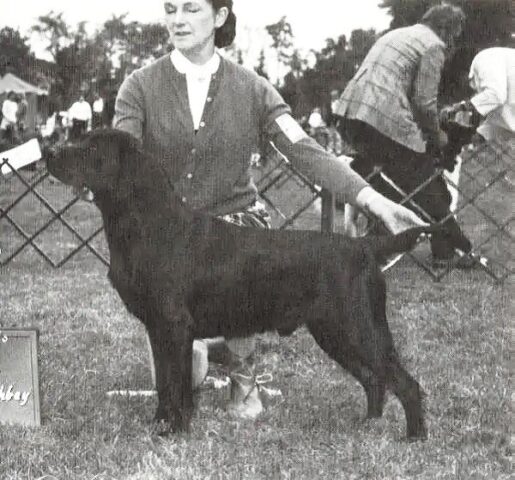
Champion Lockerbie Stanwood Granada
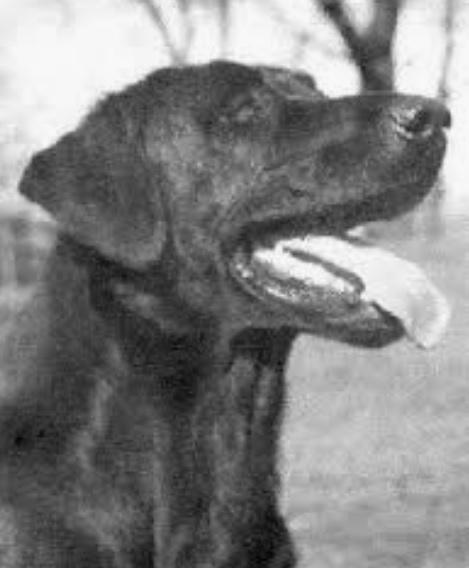
Dual Champion Canadian Field Champion Little Pierre of Deer Creek
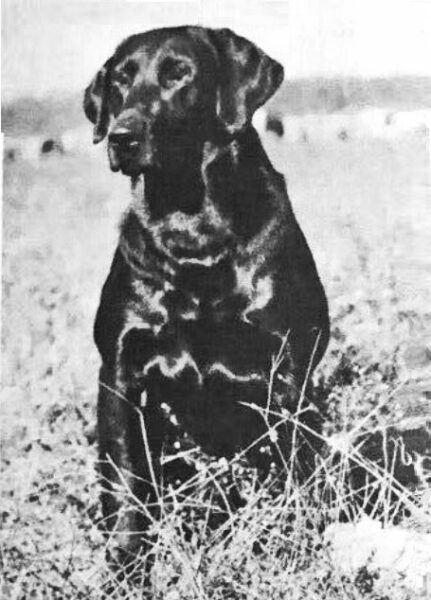
Dual Champion Grangemead Precocious
1956 Officers
President William K Laughlin
Vice President- Eastern Clifford V Brokaw Jr
Vice President-Mid-West Dr George H Gardner
Vice President-Pacific Coast Sandy F MacKay
Secretary/Treasurer CA Griscom III
Director Paul Bakewell III
Director Claude Bekins
Director Guthrie Bicknell
Director JH Lee Fisher
Director AA Jones
Director TW Merritt
Director Dr Samuel Milbank
Director Junius S Morgan
Director Lewis E Pierson Jr
Director J Gould Remick
Director A Wells Wilbor
and all the officers
Information courtesy of:
The Labrador Retriever Club
25th Edition
1931-1956
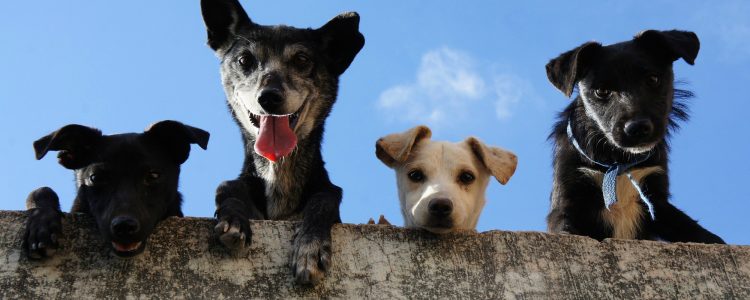
Many people would have you believe the spay neuter decision is easy. “Yes!” and “Right away!” they’ll say. “We have to prevent pet overpopulation and animal suffering!”
But it’s not that straight forward. Not every intact animal contributes to overpopulation. Nor is spaying and neutering without pain and suffering.
Rescue organizations support spay neuter
As a country, I think we’ve made great strides in controlling pet overpopulation. Are there still animals in need? Certainly. Is spay neuter the answer in every case? No.
I believe our rescue organizations are desperately needed and deserve thanks from every pet owner. However there are still animals who wind up in shelters and never leave. I’ve been there. I’ve seen the piles of animals that had been “put to sleep.” It’s heart wrenching.
But spay neuter and rescue programs have helped to greatly reduce the number of animals in the shelters. In some cases the programs have worked so well the shelters need to import strays for local people to adopt. USA Today ran a story that an organization in Puerto Rico had shipped over 14,000 strays to the US for adoption.
Spay and neutering campaigns have been so successful in much of the USA — especially the Northeast and Northwest — that shelters need to look elsewhere if they want dogs to offer for adoption.
We shouldn’t be importing pets – and potential diseases – just to keep rescue organizations in business. Canine brucellosis was almost eradicated in the United States, but rescue groups in Wisconsin imported two dogs from South Korea that tested positive. This is a zoonotic disease which means it can spread to people as well as other dogs.
Several other imported dogs had rabies. At least one dog had been adopted by a family in Pennsylvania before they discovered he was infected. At that point, at least a dozen people may have been exposed.
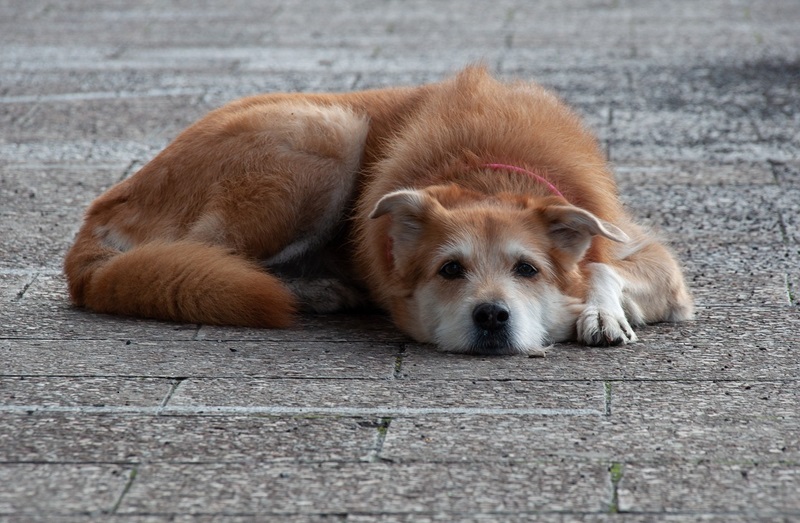
Image courtesy wal_172619 via Pixabay
Health impacts of spay neuter procedures
Spaying and neutering has been good in some ways for society. But what about for the individual animal? There are many health consequences from these surgeries and plenty of misinformation.
“It’s a routine procedure.”
It may be routine for some animal hospitals, but it’s still surgery and, in the case of spaying, major surgery. There are risks from the surgery itself, from anesthesia, and from infection.
“It will reduce behavioral problems such as aggression and wandering.”
It may or it may not. Generally behavioral problems are better corrected through training.
“It can significantly prolong your pet’s life.”
Again, it may or it may not. There are several studies pointing to increased risk of various cancers and orthopedic issues due to spaying and neutering. There is also a study that showed female dogs lived longer if they were not spayed until at least six years of age.
“Spay neuter can make your dog friendlier and less likely to bite.”
Surgery doesn’t generally affect a dog’s temperament, although some studies suggest spaying or neutering can actually lead to more aggression.
“Irresponsible breeding is the root cause of most vicious dog bites and attacks.”
Poor temperament can certainly be inherited, but many dog bites are due to a training issue. There’s either a lack of training that lets a dog become an alpha or training designed to make a dog vicious.
“Spaying and neutering makes happier and healthier pets.”
A study found that “spayed female dogs tend to be more aggressive toward their owners and to strangers than intact females.” And there wasn’t much evidence that neutering would stop aggressive behavior in male dogs.
Spay neuter procedures explained
Spaying is surgery to remove a female dog’s reproductive organs.
Before the surgery, the veterinarian draws a blood sample. This checks the dog’s liver and kidney function because these organs break down and remove anesthesia after the surgery.
If all is well, the dog is sedated and her belly shaved and cleaned. The veterinarian cuts into the belly and removes the ovaries, fallopian tubes, and uterus. Then the incision is closed with sutures or glue and the dog is monitored as she recovers from anesthesia. Often she will remain at the hospital overnight.
After the dog goes home she will need to be kept quiet and prevented from licking or chewing on the incision.
Neutering is surgery to remove a male dog’s testicles.
As with female dogs, the veterinarian should draw blood to check for liver and kidney function.
Then the dog is sedated and cleaned before the veterinarian cuts into the scrotum. Each testicle is removed, the blood supply tied off, the incision closed, and the dog is monitored as he recovers. The dog should be kept quiet and prevented from licking or chewing on the incision.
Occasionally one or both testicles may be retained inside the body. In these cases the surgery is more involved and can be higher risk. These testicles are at risk of developing cancer so they should be removed or at least monitored via ultrasound.
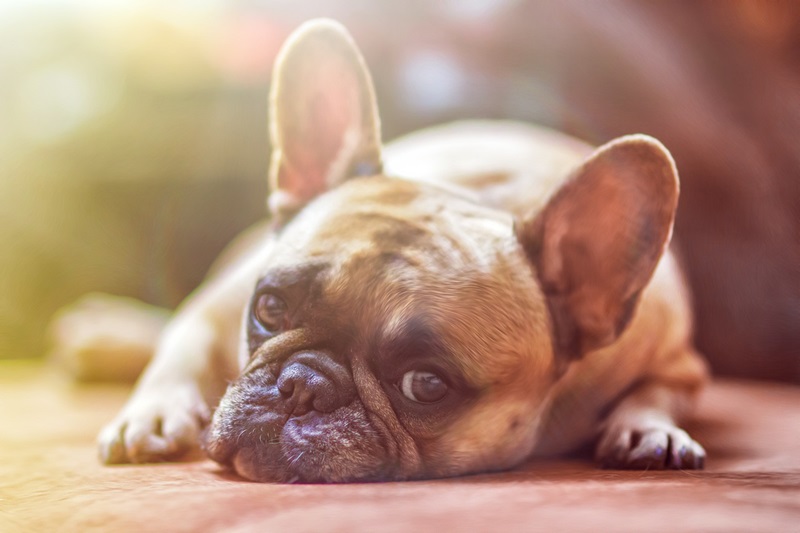
Image courtesy whitedaemon via Pixabay
Advantages of spay neuter procedures:
- Prevents pregnancy and its risks
- Prevents females from coming in heat every 6-12 months
- Reduces or eliminates the chance of some cancers
- Reduces the risks of non-cancerous prostate disorders and perianal fistulas
- May reduce leg-lifting or marking by males
- May reduce the cost of licensing and/or HOA fees
Disadvantages of spaying and neutering:
- Costs of the surgery
- Risks of surgery, anesthesia and complications. Studies show about 20% of spay or neuter surgeries have at least one complication. Your dog may die due to the surgery. It doesn’t happen very often, but it’s pretty devastating when it happens to YOUR pet.
- INCREASED risk of other deadly cancers
- “INCREASED likelihood of hemangiosarcoma, lymphoma, mast cell tumors, and canine cruciate ligament (CCL) rupture in neutered dogs.”
Should you spay neuter your dog?
It should be up to you, based on complete and accurate information and the needs of you and your dog. You shouldn’t be pressured into a decision either way.
A big problem is that alleged health benefits are discussed, but rarely any evidence supporting that viewpoint. Also rarely discussed are the health risks of spaying and neutering.
Potential risks of neutering male dogs
- The risks of prostate or testicular problems are fairly low and, if any do occur, the solution generally is to neuter. On the other hand, there are other increased health risks due to neutering.
- If neutered before one year old, significantly INCREASES the risk of osteosarcoma (bone cancer). A common cancer in medium/large breeds with a poor prognosis.
- INCREASES the risk of cardiac hemangiosarcoma by a factor of 1.6. “According to Aaha.org, hemangiosarcoma is known as a “silent killer” because dogs often show no symptoms until the tumor has grown so large that it ruptures and spreads—too late to save the dog’s life.”
- TRIPLES the risk of hypothyroidism. A common disease that can be tricky to diagnose, but is fairly easy to treat. However the dog will need daily medication for the rest of his life.
- INCREASES the risk of progressive geriatric cognitive impairment.
- TRIPLES the risk of obesity, a common health problem in dogs with many associated health problems.
- QUADRUPLES the small risk (<0.6%) of prostate cancer
- Doubles the small risk (<1%) of urinary tract cancers
- INCREASES the risk of orthopedic disorders
- INCREASES the risk of adverse reactions to vaccinations.
Overall it seems the negatives associated with neutering are greater than not neutering. The exception being a dog with retained testicles should be neutered.
If you choose to neuter, you might reduce some of the negatives by waiting until the dog is mature – perhaps a year old for smaller breeds and two years old or more in large breeds.
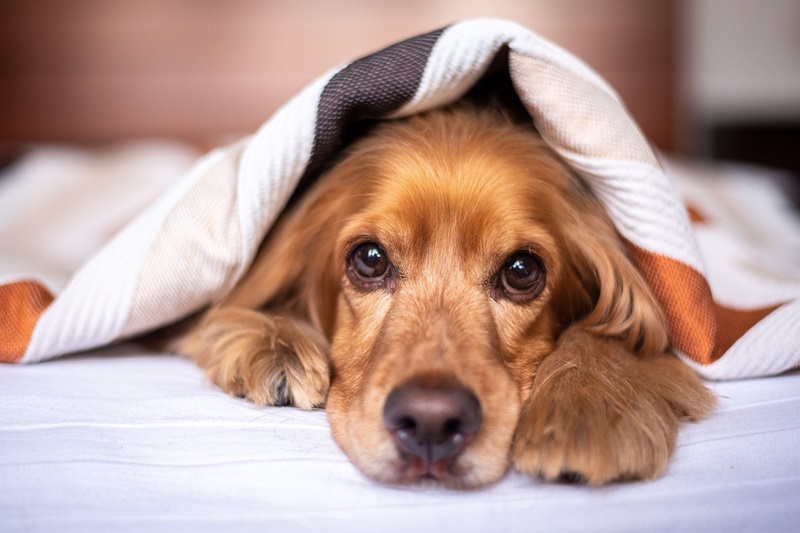
Image courtesy Alkhaine via Pixabay
Potential risks of spaying female dogs
The decision for females is not so easy.
Uterian cancer, mammary tumors and pyometra can all be life-threatening. Pregnancy complications can also be deadly. Spaying can reduce, and in some cases nearly eliminate, these risks.
Also results can be different depending on WHEN they are spayed with early spaying having higher risks of various problems. A longevity study suggests females may live longer if they’re not spayed until they’re at least 4-6 years old. But each heat cycle increases the chance of pyometra and breast cancer.
According to The National Animal Interest Alliance, the negatives of spaying female dogs include:”
- If done before one year old, significantly INCREASES the risk of osteosarcoma (bone cancer). A common cancer in medium/large breeds with a poor prognosis.
- INCREASES the risk of splenic hemangiosarcoma by a factor of 2.2 and cardiac hemangiosarcoma by a factor of >5. This is a common cancer and major cause of death in some breeds.
- TRIPLES THE RISK of hypothyroidism.
- INCREASES the risk of obesity by a factor of 1.6-2, a common health problem in dogs with many associated health problems.
- Causes urinary “spay incontinence” in 4-20% of female dogs.
- Increases the risk of persistent or recurring urinary tract infections by a factor of 3-4.
- Increases the risk of recessed vulva, vaginal dermatitis, and vaginitis, especially for female dogs spayed before puberty.
- Doubles the small risk (<1%) of urinary tract tumors.
- Increases the risk of orthopedic disorders.
- Increases the risk of adverse reactions to vaccinations.
For a little more insight on spaying females, there is a study that concluded shorter lifespan was associated with spaying. They looked at Rottweilers that had an average lifespan of about 9-1/2 years compared with Rotties who lived to at least 13 years old.
Females tend to live longer than males, but it didn’t hold true for females that were spayed before 4 years old.
As they dug deeper, their results showed that how long females kept their ovaries affected how long they lived. If they were at least six years old before being spayed they were 4.6 times more likely to live an exceptionally long life. When they excluded all deaths due to cancer, they found “females that kept their ovaries the longest were 9 times more likely to reach exceptional longevity than females with shortest ovary exposure.”
If you don’t plan to breed your female, spaying would probably be the better choice, particularly if you delay the surgery until your dog is mature.
If you do have a breeding-quality female and plan to breed her, puppies nursing may provide some protection against the risks to unspayed females. Another option for unspayed females is postponing her heat cycles with a steroid, mibolerone.
Each time a female has a heat cycle her body produces increased levels of progesterone which is inflammatory to her uterus. Several heat cycles with this inflammation, particularly if she is not bred, can lead to endometritis, a uterine infection. Mibolerone can delay her heat cycle for up to two years, but must not be used before she’s cycled once naturally.
Once a female’s breeding career is over, spaying would be a good choice. Based on the Rottweiler study, waiting to spay until she is over six years old may help to extend her life.
Other options
With all the potential health issues caused by spaying and neutering, another option you might consider is hormone-sparing sterilization. These are more like a hysterectomy or vasectomy in people.
A female dog would have her uterus removed, but not her ovaries. She would still have heat cycles due to her hormones, but bleeding is eliminated. Ovarian and breast cancer are still possible, but the risk of ovarian cancer is small. Regularly rubbing her belly – particularly after she reaches middle age – can alert you to any suspicious lumps that could develop into cancer.
For male dogs, your veterinarian would cut the vas deferens – the tube that transports semen. There is still a chance of testicular cancer or an enlarged prostate, however these can usually be treated by neutering. In the meantime, he would have benefited by retaining his natural hormones until then.
The problem is that few veterinarians are trained in these procedures. Hopefully that will eventually change.
There are also some non-surgical options. Zeuterin (also labeled EsterilSol in some countries) is an injection that sterilizes male dogs. Unfortunately it’s not currently available from the manufacturer. Suprelorin is an implant for male dogs to prevent fertility. It takes about 2-3 weeks to reduce testosterone and 6 weeks to infertility. It lasts about 6-12 months. Unfortunately it is only available in a few countries, but not in the US or Canada.
Of course, another option is responsible pet ownership. In some countries, neutering is very uncommon or even outlawed. However it does take more effort, especially with an intact female.
Key Takeaways for Pet Owners
Spaying or neutering can have profound effects on your dog’s health and longevity. Consider the pros and cons. If you do decide to spay or neuter, wait at least until your dog is fully mature. This may be about one year old for small dogs and two years (or more) for large dogs.
Listed below are some websites with more information:
Gonadectomy – Rethinking Long-Held Beliefs
Long-Term Health Risks and Benefits Associated with Spay / Neuter in Dogs
Aggression toward Familiar People, Strangers, and Conspecifics in Gonadectomized and Intact Dogs.
Assisting Decision-Making on Age of Neutering for Mixed Breed Dogs of Five Weight Categories: Associated Joint Disorders and Cancers
Rottweiler study links ovaries with exceptional longevity
Determining the optimal age for gonadectomy of dogs and cats
Alternatives to traditional spay and neuter – evolving best practices in dog sterilization
Norway bans pet sterilization without a medical reason
Header image courtesy Edgar Daniel Hernández Cervantes via Pexels

So, you’ve decided a get a silver Lab. They’re trendy. They’re more unusual than other Labs. And they come in other uncommon colors such as charcoal and champagne.
Before you dig out your wallet though, learn about how they were created and the health issues they often have. Learn the truth about the silver Labrador myth.
Early Labrador History
The Labrador Retriever originated in Newfoundland and the early dogs were black. Some had white markings from the St John’s dog.
Several of these dogs were imported to England and Scotland during the 1800s. Impressed by their retrieving desire and overall work in the field, wealthy sportsmen imported more dogs and began breeding them. In the early 1900s, sportsmen in America began importing and breeding Labs.
The majority of these dogs were black, but breeders documented an occasional brown or yellow puppy. But black was – and still is – the most common color.
It’s notable that none of these early Labs were described as silver colored.
Origin of the Silver Labrador Myth
According to the Factual Review by Margaret Wilson, “There was never any mention in the meticulous and exhaustive breeding records, whelping logs, descriptions of markings colors, etc., and stud books kept by gentlemen of unimpeachable integrity of any dog being produced that was, in fact or in fantasy, a dilute. Not in ANY of the retriever breeds developed from the St. John’s dog during that time in Great Britain. The dilute allele was introduced after the establishment of the recognized breeds. In the case of the Labrador this introduction occurred in the USA during the latter part of the 20th century.”
Because a variety of breeds were crossed with Labs early in their history, occasionally mismarks popped up. Some had tan markings like a Doberman, some were brindled like a Great Dane, and some were splashed with white. These mismarks are rare, but they do still occur. Unlike the “silver Labs”, these dogs are considered purebred Labs.
There was no mention of “silver Labs” until the mid-twentieth century. And for years after that, they were only found in the US. There were none in the United Kingdom until 2006 when some silvers were exported from the US. If these silver dogs were purebred Labradors they should have appeared a long time ago in the breed’s home country.
Origin of the silver color
The color most likely comes from the Weimaraner which has “shades of mouse-gray to silver-gray” per the breed standard. Every dog of this breed has two copies of the recessive dilution gene (“dd”) which causes the silvery color.
The Labrador Retriever, however, does not have the dilution gene. A purebred Lab has “DD” genes which means they have two copies of the dominant, non-dilute gene.
Crossing Labs with Weimaraners will produce dogs with normal Lab colors, however, they will all carry the dilute gene (“Dd”).
Breeding these dogs together can produce dogs that don’t carry the dilute gene and dogs that carry one copy of that gene. These dogs will have normal Lab colors.
However, that cross can also produce dogs that have two copies of the dilute gene (“dd”) with diluted colors.
The dilute colors have been named “charcoal”, “champagne,” and “silver.” These dogs often have a lavender cast to the coat and light greenish eyes, both traits from the Weimaraner.
Honest Labrador breeders test their dogs for the dilute gene. A Lab with correct coat color – black, yellow, or chocolate – will be either DD or Dd. The DD means the dog does not carry the dilute gene. That small “d” means the dog has correct color, but also carries the dilute gene and is therefore a mix-bred.
The start of the silver Labrador myth
Just about every “silver Lab” can be traced back to two breeders – Crist Culo Kennels and Beaver Creek Labradors. They gained notoriety in the mid-1980s. Neither has a current website.
In 1987 the American Kennel Club (“AKC”) investigated a litter of silver puppies. After looking at the puppies and paperwork they decided “there was no reason to doubt that the dogs were purebred Labrador Retrievers.” That statement is not the same as saying the dogs were purebred. Rather it meant they had no proof the dogs were of mixed parentage. Genetic testing would likely have proven the records were falsified, but without it they relied on the breeder’s word. Read on to learn about his truthfulness. Or lack thereof.
Crist Culo Kennels
Dean Crist was the first person to market “silver Labs” and was adamant that they were purebred Labs. He even “offered $100,000 to anyone who could simply prove” he was cross-breeding to produce “silver Labs.” It was a safe bet without genetic testing.
The dogs at Crist Culo Kennels were intensely inbred. This was likely done to increase the number of dogs carrying the dilute gene and thus his profit margin.

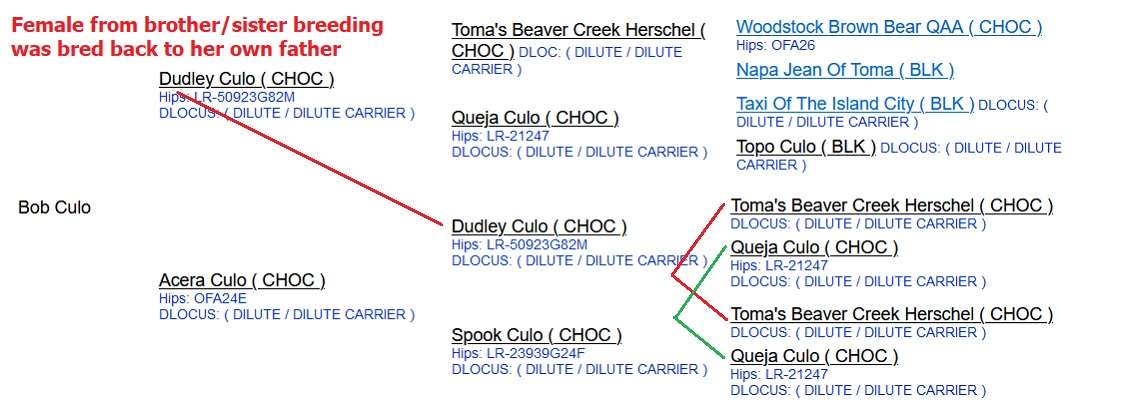

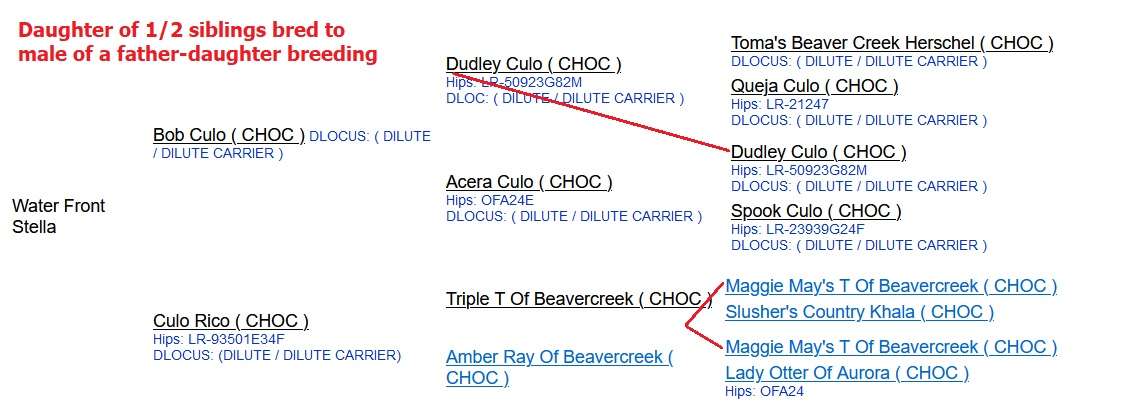
Crist claimed, “… AKC will eventually have to concede to the growing public pressure to make Silver a recognized color for Labs in America.” He didn’t know that AKC doesn’t have the power to make silver a recognized color of Labradors. The Labrador Retriever Club (“LRC”) controls the breed standard and they don’t recognize “silver Labs” as purebred.
He claimed, “Chocolate Labs were both controversial and rare in the U.S. in the early ‘80s.”
Although not as common as black Labs, chocolates were not controversial nor rare and many were champions:
Am Mex CH Gunfields Super Charger CD WC (born 1969),
CH Wingmasters Cobe of Mandigo CD (born 1972),
CH Shamrock Acres Pot of Fudge CDX (born 1975),
CH Wingmaster’s Swiss Ms CD (born 1977),
FC Mueller’s Stormy Canada (born 1980),
Crist said, “…allergies … occur at the same frequency in Silver Labs as they occur in Chocolate Labs.” He blamed puppy buyers for feeding a poor diet. Silver Labs commonly have color dilution alopecia, a genetic disorder that causes the dog to lose most of its hair.
Although retired from breeding, other silver breeders continue to spread his false information.
Beaver Creek Labradors
This kennel showed up in the 1990s – about 10 years after Crist Culo. They practiced less intense line breeding – using distant relatives – compared with the inbreeding done at Crist Culo Kennels. According to Crist, this kennel culled silver puppies until they saw him advertising “silver Labs” for sale. He volunteered to sell the puppies for them so they could avoid the backlash of cross-breeding. Eventually, they chose to market their own puppies.
Other people decided to try breeding silvers. Some sourced their first dogs from early breeders, while others decided to breed their own “silver Labs.” At least one breeder was caught falsifying records and was suspended from AKC.
Explaining the appearance of silver Labs
There are a variety of stories told to explain the sudden appearance of “silver Labs” in the 1980s.
Some silver breeders point to gray puppies noted by Mary Roslin-Williams. However, they only included the part that makes it seem like “silver Labs” have been around for many years. What they didn’t share is that when those puppies shed their puppy coat they were black. Not silver, not charcoal.
A researcher traced many silver pedigrees back to dogs from a large mid-western kennel. To register crossbred puppies with the AKC, a false name and registration number from a Lab had to be used as the sire. Therefore the dogs he pointed to were likely the “parents” only on paper as the actual sire was probably a Weimaraner.
Another oft-repeated myth is that the level of inbreeding at the Culo kennel resulted in the silver color. Rather the tremendous amount of inbreeding in these early silvers suggests producing the silver color was deliberate.
It only took one fraudulent breeding to introduce the dilution gene to the Lab breed. Then lots of inbreeding to develop a line of “silver Labs.” Since then there have been many more fraudulent registrations of Labrador x Weimaraner crosses registered as purebred Labs.
Interesting how there were no “silver Labs” until the mid-1900s. And for years after that they were only found in the US. There were none in the UK until many years later. The silvers there were all imported from the US or descended from imports. If these dogs were purebred Labradors they would have shown up a long time ago in the breed’s home country.
Creation of “Silver Labs”
They are a cross of a chocolate Labrador Retriever and Weimaraner. A first generation dog could look more like a Lab or more like a Weimaraner. Breeding together two first generation mixed-bred dogs could result in puppies with the silver color.
If the Labrador grandparent was black or yellow, some of the second-generation puppies could be a lighter shade of black or yellow. These colors were called “charcoal” and “champagne.”
Years ago it was really hard to tell a silver Lab from a Weimaraner. Unless you looked at the tail. In the US, Weimaraners have their tails docked to six inches. Other countries have outlawed cropping ears and docking tails, so looking at the tail in those locations is not helpful.
Over time, silver breeders have bred their dogs to purebred Labs so the silvers are looking more Lab-like. And they decided to lie and declare their mixed-breed dog are purebred Labradors. This is the silver Labrador myth.
Health Issues
Silver Labradors are prone to color dilution alopecia which is a painful and chronic condition linked to the dilute gene. Dogs appear normal as puppies, but at about six months begin to lose their hair. Some dogs may only have bald spots while others may lose all of their hair.
Affected dogs may develop infections and granulomas which are the body’s attempt to wall off foreign bodies. There is no cure.

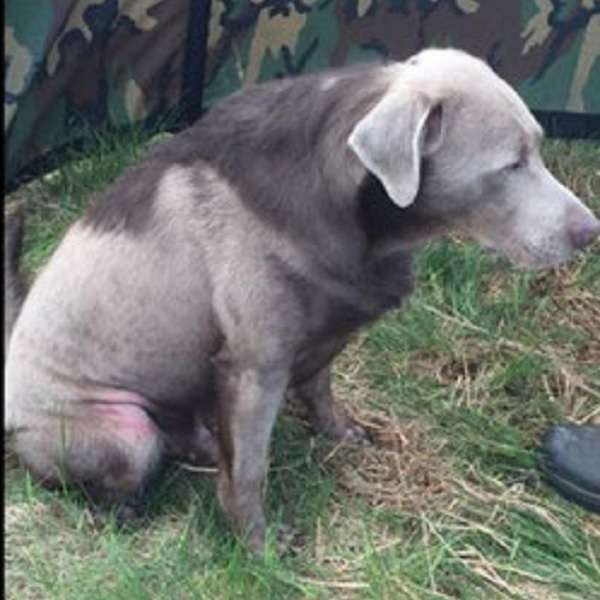
Silver Labrador Myth Around the World
“The overwhelming consensus among breed experts from legitimate Labrador clubs, the position of these accredited Labrador clubs, and a growing number of recognized purebred dog registries, is that the dilutes are the result of a cross breeding, with Weimaraner being the source of the dilute allele, and are therefore are not registerable in a purebred registry.” LRC_News_Spring2018.pdf
In addition, the breed standards for Labrador Retrievers around the world only recognize the colors of black, chocolate and yellow. AKC lists any other color as a disqualification. Labs with the diluted color cannot be shown. Some countries do not allow them to be bred.
Labrador Retriever Club Inc.
The LRC is the parent club for the breed in the US and they are the liaison to the AKC. They do not condone the breeding of silver Labs and have “good evidence in scientific literature indicating that the Labrador has never been identified as carrying the dilute gene…”
In other words, these dogs are not purebred Labradors.
The United Kennel Club and Hunting Retriever Club
The UKC standard is clear. Any color or combination of colors other than yellow, black, or chocolate is a disqualification. UKC does not recognize any form of silver coloration as a variation of the chocolate color. It does not knowingly accept registrations for Labradors that have a silver coat coloring.
Further, they are not eligible to run in HRC hunt tests because the tests are only open to gun dog breeds. Dilutes are not considered purebred Labradors. They can participate in other UKC performance events but must be neutered.
Great Britain
Dilute colors in Labradors are not recognized
Canada
Not a breed standard recognized color for Labrador Retrievers
The Netherlands
Dilute colors are not naturally occurring in Labradors. Breeding dilute Labs is banned.
New Zealand
At least one parent must be clear of the dilute allele.
Australia
Dilute Labradors may not be registered.
American Kennel Club
On the other hand, the AKC is a registration body. Its position is if two dogs have full registration and are registered as the same breed, they will register their puppies.
Weighing the facts
Ultimately if silver breeders were truthful there would have been some backlash, but not to the extent caused by the lies. What Labrador breeders object to is calling these dogs “silver Labs” when they have Weimaraner characteristics beyond the silver color. It’s particularly noticeable in the head, ear shape, and eye color.
Too many lies have been told and too much false information has been spread by the silver breeders. The LRC has offered to help them set up their own breed, but they’ve refused. So it’s time to ferret out every one of these cross-bred dogs and stop calling them Labrador Retrievers.
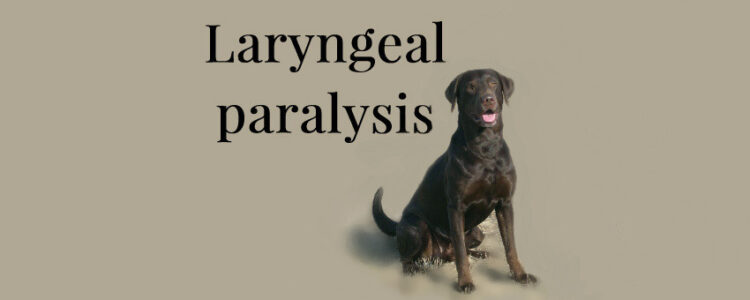
When my chocolate Lab was about 13 years old I noticed his bark was sounding hoarse. I thought he had a cold but after a check up with my veterinarian I learned it was laryngeal paralysis.
I made some changes to his care and lifestyle that helped him live to 17. He even “applied” for a drivers license on his 16th birthday.
Laryngeal paralysis in older dogs
The hoarse bark is a telltale sign of Laryngeal paralysis. Some dogs might have noisy or labored breathing. Others might faint from a lack of oxygen.
When you swallow wrong we often say “it went down the wrong pipe.” What happens is the flaps at the entrance to your windpipe didn’t close fast enough.
Laryngeal paralysis is the opposite – the flaps don’t open fully or sometimes not at all. That can cause several other symptoms such as:
- Noisy or raspy breathing
- Excess panting
- Coughing
- Gagging
- Regurgitating
- Exercise and heat intolerance
- Difficulty breathing
- Tongue or gums turning blue
- Collapse
The larynx – or voice box – is at the top of your dog’s throat. It regulates his breathing and includes vocal cords that make it possible for him to bark, growl, and whine.
This is where we find those flaps that keep food or liquid from entering his windpipe.
Sometimes because of age or injury, the larynx might not open completely. This can restrict your dog’s breathing, especially when excited or playing hard. He might also become anxious, pant excessively, cough, or gag.
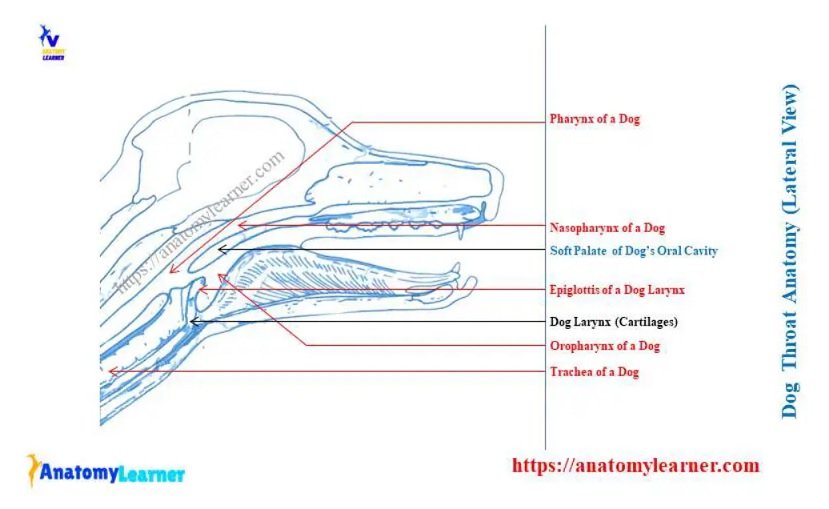
What is laryngeal paralysis?
Laryngeal paralysis is common in larger breeds, in dogs over 8-10 years old, and in male dogs. Although many breeds can be affected, Labradors seem to be affected most often.
It is often part of a neurological condition called Geriatric Onset Laryngeal Paralysis Polyneuropathy. GOLPP may cause mild symptoms for years or it can be part of a series of neurological dysfunctions.
Mega-esophagus is one symptom of GOLPP. This happens when food piles up in the esophagus instead of continuing into the stomach. If too much food gets stuck in the esophagus it can cause the dog to vomit. Aspiration pneumonia is another potential problem.
Another neurological dysfunction causes weakness in the rear legs. Often mistaken for arthritis, it’s actually caused by the same nerve problem that causes laryngeal paralysis. Slow leash walks and physical therapy can help weak rear legs.
Currently, there is no cure for GOLPP.
Causes of laryngeal paralysis
A genetic condition can cause laryngeal paralysis, especially in Siberian Huskies, Bull Terriers, Bouvier de Flanders, Great Pyrenees, and Dalmatians. Symptoms often begin in puppies under a year old.
There is also a non-genetic form that is likely caused by a neuromuscular disease. Or it can be caused by trauma, such as surgery, tumors or injuries to the neck.
Understanding the underlying cause is important as it helps guide treatment and care options.
Symptoms of Laryngeal Paralysis
Altered bark
Your dog’s ability to bark can be affected by laryngeal paralysis. It might become hoarse, weak, or even completely silenced. This change in the ability to make himself heard can be troubling for your dog.
Changes in breathing patterns
A change in the way your dog breathes is one of the most common signs of laryngeal paralysis. You may notice an increased effort to breathe, a raspy sound while inhaling or exhaling, and sometimes breathing difficulty. Sometimes it can sound like a goose honk.
When your dog’s breathing is restricted it can cause him to tire easily, faint or in severe cases, to die. Let your veterinarian know if you notice any changes in your dog’s breathing.
Exercise and heat intolerance
Dogs with laryngeal paralysis may have trouble working or playing and might tire more easily. They might need frequent breaks even during regular walks.
They may also have trouble regulating their body temperature which can make heat stroke more likely. Be sure to provide plenty of cool water and shade on hot days.
These symptoms are caused by the restricted breathing. Panting helps cool your dog’s temperature, but laryngeal paralysis can prevent him from panting effectively.
Other symptoms can include gagging, difficulty swallowing, noisy breathing, extreme panting, and exercise intolerance. If the larynx can’t close completely, food or liquid might “go down the wrong pipe” causing him to cough.
Diagnosis and treatment
If you notice potential symptoms of laryngeal paralysis, make an appointment with your veterinarian. The visit should include a medical history and a thorough physical examination.
Your veterinarian will likely listen to your dog’s chest and throat. He might also use X-rays or a scope with a camera which would require light anesthesia. Sometimes additional tests are needed.
Treatment options can depend on the severity of your dog’s symptoms and his state of health. In mild cases, medical management may be enough to relieve symptoms.
Medications might include mild sedatives to decrease anxiety and panting, which will improve respiration. Corticosteroids can help decrease any inflammation and edema (swelling) of the larynx.
You might need to make some changes such as taking walks in the cooler part of the day. If he’s overweight, helping him drop the extra pounds can make it easier to move around without huffing and puffing.
Here is a video of a dog that became anxious at the veterinary hospital and had trouble breathing.
Surgical intervention
In severe cases surgery could be considered. This procedure – often called “tie-back surgery” – permanently tacks open one side of the larynx which allows more air through and improves quality of life. Unfortunately this increases the risk of aspiration pneumonia and choking.
It also means no more swimming because dogs often swim with their mouths open. With one flap always open, he could drown.
After the surgery veterinarians will often prescribe a drug to help food pass quickly through the digestive tract. This helps prevent food from coming back up through the open larynx.
They may also prescribe anti-vomiting drugs for the same reason.
Be sure to check with your veterinarian about the potential benefits and risks to your dog.
Other options
Although there isn’t a cure for laryngeal paralysis, there are ways to minimize the symptoms.
You could choose a laryngeal stent implant instead of tie-back surgery. It doesn’t require surgery, it’s more affordable, and it only takes a few minutes.
Here’s one family’s story as they struggled to help their dog. At that time most veterinarians didn’t know – or perhaps didn’t care to know – about using a stent.
Acupuncture has helped manage symptoms. “Two acupuncture treatments four weeks apart were performed with marked improvement of clinical signs over a 6 week period. The patient continues to do well 16 months after the last treatment.”
An antidepressant drug called Doxepin seems to help 50-75% of dogs, however it doesn’t help with the underlying cause. Also it should not be given to dogs with glaucoma or heart disease. Because this is an off-label use for the drug you may need to sign a waiver before your vet will prescribe it.
The treatment plan should be tailored to your dog’s individual needs to improve quality of life and manage symptoms.
Caring for a dog with laryngeal paralysis
There is no cure, but mild cases can be managed using the following tips:
- Have plenty of fresh water available and a cool place to relax
- Reduce stress
- Provide anti-anxiety medications when necessary
- Use a sedative during exciting or stressful times
- Limit exercise, especially during hot and humid weather
- Use a harness rather than a collar to keep pressure off the throat
- Reduce excess weight
- Provide physical therapy to help rear leg weakness
- Check out ToeGrips if you have slippery floors
- Buy elevated bowls to reduce the risk of aspiration
- If your dog also has megaesophagus, a special chair called a “Bailey Chair” can help your dog sit upright and supported. Gravity helps the food “fall” into the stomach. Experts recommend feeding soft food and having your dog sit upright for 15 minutes after feeding.
Also schedule regular check-ups with your veterinarian. These follow-up visits will give him a chance to check your dog’s breathing, overall health, and response to treatment.
Recognizing and responding to emergencies
For a dog with laryngeal paralysis, problems can quickly become critical.
If you notice severe breathing difficulties, pale gums, excessive panting, or collapse, it can be a life-threatening situation. It’s important to act quickly. Be prepared to seek emergency veterinary care.
Summing up
All dogs with laryngeal paralysis need extra monitoring, some more than others. Learning about the symptoms and treatment options available can help you provide the best possible care.
Work closely with your veterinarian and don’t hesitate to seek their guidance when needed. Your care and support can help your dog continue leading a happy life.
NOTE: The information on this website is not intended to replace your veterinarian’s advice. This information is intended to provide non-technical information in an easy-to-understand format. The website author accepts no responsibility or liability for how this information may be interpreted or construed, or any actions that might be taken as a result of the information herein.
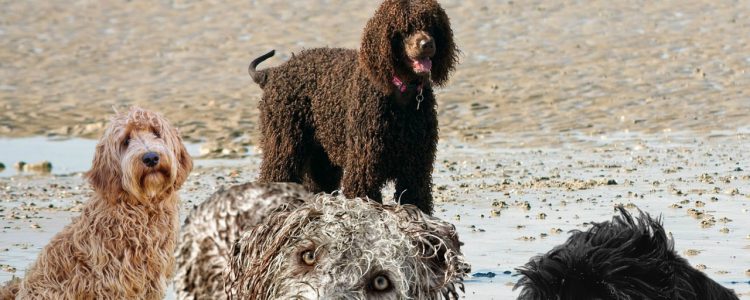
Learn about LabraDoodles – what they are, their good points and their bad points – before you go see a litter of puppies.
They’re not purebred
Despite what some people might say, a LabraDoodle is a crossbreed, just like the so-called “Silver Labs.”
It’s a marketing ploy. They slap a cute name on something (like “LabraDoodle”, “Puggle” or “Poochon”) and charge a high price to make you think it’s special or a “designer” breed.
What they are is a cross between a Poodle and some other breed, such as the Labrador Retriever.
Unfortunately when you cross two different breeds, you get a mish-mash of genes.
Mixed genetics = lots of unknowns
They don’t come out the same way each time. It’s unpredictable – looks, coat, behavior and health.
You might get a puppy that looks like a Lab, but acts like a Poodle. You might get a tall one or a short one.
It could have a coat that’s wiry or soft, or curly, wavy, or straight. Many doodles do shed and some need to be shaved every 6-8 weeks.
The good, the bad, and the ugly
The good
LabraDoodles and other Poodle crosses can be adorable. So cute and fluffy you want to cuddle them.
Each dog is unique. Some might get the Poodle coat while other dogs have a Labrador coat. Same with temperament.
The bad
You don’t know what you’re getting. One Doodle might have a Labrador temperament, while another is more Poodle-like.
Owners are often surprised to find they are allergic to their dogs
You may also get a puppy that inherited the genetic problems or diseases from BOTH breeds.
Or you might get poor temperament despite the docile Lab temperament that is often advertised.
LabraDoodles tend to be noisy. Some LabraDoodles are high-strung and may not be good with children.
They can also be needy and crave attention which makes them a poor choice if there is no one home during the day.
Depending on the size of the Poodle parent, Doodles can be small-ish or can be 80-pounders.
All of them need special grooming. It’s not bad if they got the coat of one parent or the other, but some might have a mixed coat.
Many groomers refuse Doodles, but for the groomers who do accept them expect to pay $125-200 for each session.
Some boarding kennels refuse them.
You’ll need to brush them often and make regular grooming appointments. Start this while they are still puppies or you might not find a groomer willing to work on your dog.
If Doodles aren’t groomed every week – down to the skin, not just the surface fur – they may need to be shaved. Dogs don’t like this. Groomers don’t like this.
The ugly
Without proper socialization and training, LabraDoodles can be terrors. They can scream and bite.
They tend to be mouthy, so provide plenty of chew toys.
And, yes, it can get ugly when they get lonely or bored.
Pulling back the curtain
After paying 2-4 times the cost of a purebred Lab or Poodle, owners sometimes dump them at shelters. Too often it’s due to aggression towards children.
“Designer dog breeds that most end up in shelters are poodle mixes [like] labradoodles, goldendoodles, [and] cockapoos). It’s mostly because they are adopted by busy owners who are not ready for their high energy levels” according to AZ Animals.
Because of the high price people are willing to pay, Doodles are the “breed” of choice for many puppy mills.
The man credited with creating them said he regrets introducing this mix-bred dog to the world. He was trying to breed a guide dog that was also hypoallergenic, but he failed over and over.
I opened a Pandora’s box, that’s what I did. I released a Frankenstein. So many people are just breeding for the money. So many of these dogs have physical problems, and a lot of them are just crazy.
In a nutshell
If you want a LabraDoodle, do your homework. Meet the breeder and the parents of the puppy you’re considering buying. Check temperament and trainability. Check for health certifications.
When your puppy is old enough, enroll him in a Puppy Kindergarten class. It’s good for basic training and socialization.
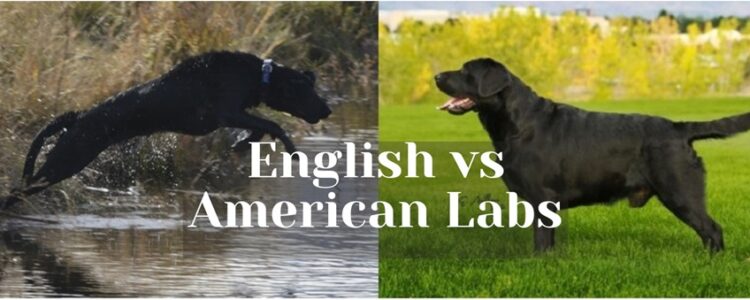
As a long-time Labrador fan, I’ve owned both the English vs American styles. Some people call them “show” or “field” Labs, as that can be less confusing.
So, what makes one dog an English Lab and another an American Lab? This guide will explain what happened.
Early Labradors in America
From the 1930s when the first Labs were imported through the 1970s, field Labs and show Labs were virtually the same. It was common for show dogs to be bred to field dogs. Even Ebonstar Lean Mac, one of the best-known field trial Labs, descends from show dogs.
Often, individual dogs were a bit better at one sport or the other, but some were good at both. During that time there were 37 Labs that earned both a show championship and a field championship to become Dual Champions.
What Caused The Split
In the 1970s and 1980s, a second wave of British imports began. Some of these dogs were heavier-bodied with blocky heads. Show fanciers in America flocked to them hoping to breed the next big winner.
Meanwhile, field trials were changing. The landscape here is bigger and more open than in England so dogs needed to go farther and faster to win.
Thus started the divergence. Show dogs became shorter and heavier. Field dogs became taller and lighter.
Because show dogs of that time had imported English blood, they were called “English Labs.” Originally only the imported dogs were called English, but over time all show-type Labs were called English. Other Labs were called American.
English vs American – Physical Differences
During three decades as the most popular breed in America, striking differences developed between the English vs American styles.
These physical differences aren’t just cosmetic, they reflect the different purposes for which the English vs American Labs were bred.
English Labs were bred for show rings, while American Labs were developed for their hunting and field trial abilities.
Energy level
Both English and American Labs are highly trainable, but their different energy levels can affect their training needs.
English Labs:
- Often easier to train for basic obedience
- May be more patient with children and other pets
- Good for therapy work and as emotional support animals
American Labs:
- Great at advanced training and complex tasks
- Thrives on plenty of physical and mental stimulation
- Good for active families and outdoor enthusiasts
Temperament
Both English and American Labs share the Labrador friendliness and eagerness to please. However, there are some slight differences in their temperaments.
English Labs are often calmer and more laid-back. They are great for families and first-time dog owners and they enjoy being a “couch potato.”
American Labs often have higher energy levels and are more athletic. They enjoy doing something, whether hunting, competing, or fetching a ball in the yard. They can also be great family dogs.
Different Purposes
The differences in appearance, energy level, and temperament between English vs American Labs are due to their varied purposes.
English Labs are bred for the show ring with a priority on their structure and looks. American Labs are bred for hunting and field trials where they need athleticism, stamina, and working ability.
Most Labs fall somewhere in between with traits from both types.
English vs American Labradors aren’t the only choices
Instead, it’s a continuum from short and heavy with a large head to tall and slender with a narrow head.
Some show males look more like a Newfoundland or a wrinkled Shar Pei. They are almost a cartoon version of the original Labs that were bred to be field dogs. However, I am seeing a shift to a more moderate dog in the show ring. An exception is at the Labrador-only shows where structure is generally excellent, but more-is-better often reigns.
Some field-bred females have the height, slender legs, and head shape of a Whippet. These dogs can spend all day hunting or retrieving at tremendous distances and still want more. They are often bred for trainability, marking ability, and intelligence rather than their looks.
In between, there are dogs that still look like a classic Labrador. Classic Labs are dogs from early in the breed’s history until the breed really started to diverge in the 1960s.
Here are a couple of classic Labs:
First, is Dual CH NFC AFC Can CH Shed of Arden, a great Lab of the past. He not only earned a show championship in two countries, but was also a three-time National Field Champion! Shed was not so tall and lanky as many of the field dogs of today, nor was he so blocky as most of the current show dogs.
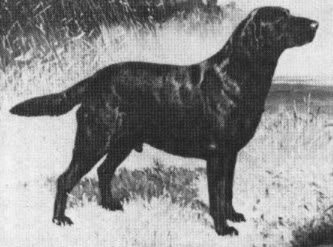
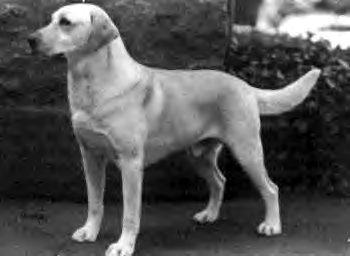
Another great from the past was CH Shamrock Acres Light Brigade. “Briggs was an outstanding show dog and sire. He produced 93 AKC Champions and won 12 Best in Show awards and 75 Sporting Group placements.” Compared to show dogs today he had longer legs and less substance, but look at those shoulders and the balance! I’d bet he moved exceptionally well.
Additionally, many people just want a Labrador and don’t breed for a specific style. The breed’s versatility and adaptability allowed it to meet many needs and yet keep it’s intelligence, friendliness, and trainability.
Choosing the Right Lab for You
When choosing between an English vs American Lab, consider your lifestyle and what you’re looking for in a dog.
- Activity Level: Do you want a more laid-back dog or an energetic exercise partner?
- Living Space: Do you have a large yard or live in an apartment?
- Time Commitment: How much time can you spend training and exercising?
- Family Situation: Do you have young children or other pets?
Remember, these are general guidelines and some dogs might be different. Always meet the dog and, if possible, its parents before deciding.
You can also check out the AKC Breed Standard to read about the “perfect” Labrador.
The differences between these types of Labs allow dog lovers to find a Lab that fits their lifestyle. Whichever you choose, you’ll have a great companion with the qualities that make Labradors one of the most popular breeds worldwide.
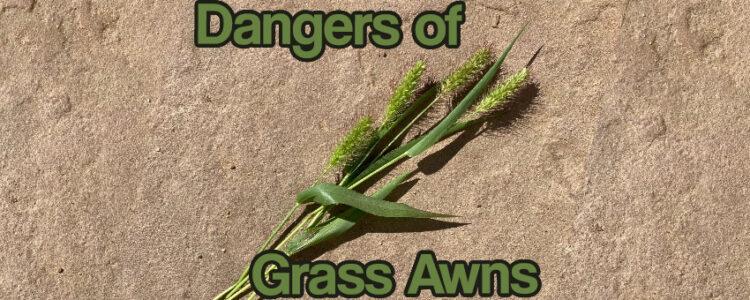
You’re probably well aware of the various health issues and hazards that can pose a risk to your dog. You might also have heard about the dangers of grass awns, but do you know why they’re dangerous?
Did you know that those idyllic fields of waving grain, as beautifully depicted in “America the Beautiful,” can pose a severe risk to your dog’s well-being? Yes, those innocent-looking plants hold the potential for grave health concerns.
Allow me to share a personal experience: Once, during our vacation, one of our dogs had a foxtail stuck in the corner of his eye. With no local vet clinics open, my resourceful mother got out her tweezers and had my brother hold our dog still. It took several minutes, but she grasped the foxtail deeply enough and pulled it out. Our little terrier was fine, if a bit put out over being so rudely man handled.
In this post we’ll learn about the dangers of grass awns and how you can safeguard your dog. Join us to learn about this hidden peril.
Understanding grass awns
What are they?
Grass awns are the seed pods of tall grasses that grow throughout North America. Sounds harmless doesn’t it?
Don’t be fooled though. They can create serious health issues in dogs and other animals.
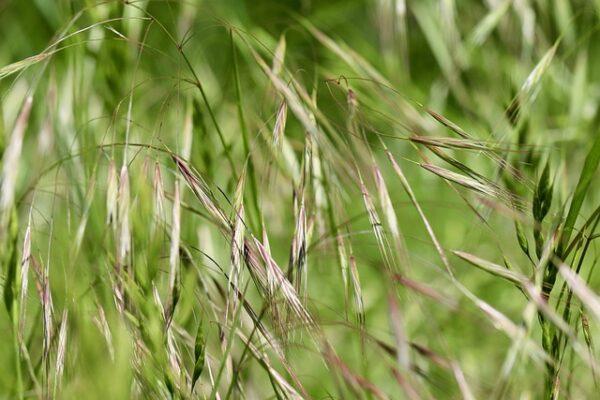
The problem is their bristle-like structure helps them stick to anything – such as your shoelaces or your dog’s fur. They can also get into your dog’s nose, eyes or other parts of his body. And backward-pointing bristles make them hard to pull out. Worse yet, when your dog moves those awns can inch forward because of the bristles. They can even penetrate the skin and migrate around inside your dog’s body causing inflammation and infection.
Grasses that produce awns include:
- foxtails
- cheatgrass
- june grass
- timothy hay
- downy brome
- needle grass
- wild barley
- spear grass
- Canadian wild rye
- foxtail barley
- winter bentgrass / ticklegrass
Where and when are grass awns found?
Grasses, whether cultivated or wild, can have dangerous awns if they are unmowed and allowed to go to seed. Anywhere grass grows – in meadows, along trails or roads, and even in your yard – they pose a risk.
The grass itself is not dangerous. It’s the seed pod – or awn – that can cause health issues.
When grasses produce their awns can vary by location and weather. Generally they go to seed during dry and warm seasons. That might be for a short time at mid-summer for northern locations. Or it could be year-round in the warm south-western areas.
Dangers of grass awns
Grass awns, with their bristles, can become entangled in your dog’s coat when he runs through tall grass. Sometimes they’re tangled so completely that they can’t migrate. Although they can be hard to brush out, doing so can spare your dog pain and potential infection.
More likely the awns will move deeper into your dog’s coat due to their arrowhead shape and backward-pointing bristles. If they’re not removed they can pierce the skin and potentially migrate throughout his body.
If your dog hunts during the fall be sure to brush him thoroughly when you get home. Or run your fingers through his coat, feeling for awns or bumps which could be ticks.
Common places awns can lodge
The most common places these awns cause problems are between the toes, or in the eyes, ears, or nostrils. They’ve also pierced the gums or skin and have worked their way in through external genital organs.
Between Toes:
Grass awns can work their way between your dog’s toes, leading to irritation and possible infection. This is especially true for dogs with long or thick fur.
Eyes:
Grass awns can get trapped in a tear duct or behind the eyelid. This can cause redness, swelling, discharge, or even scratches on the cornea.
Ears:
Because of the ear canal structure, grass awns can migrate deep within causing irritation, inflammation, and infections.
Nose:
Dogs experience the world through their noses, but that puts them in danger of inhaling grass awns. Sneezing and rubbing their nose or face is a warning sign. Sometimes these awns migrate into the respiratory system causing serious health problems.
Under the Skin:
Another one of the dangers of grass awns it that they can penetrate the skin and travel through the body’s soft tissues.
Consequences of grass awn migration
After a day’s hunt or even just a romp in a field, grass awns can cause irritation and discomfort. If they’re not removed they can pierce the skin, introducing bacteria that can lead to an infection or abscess. An awn can migrate deeper into tissues and organs causing damage and potentially serious complications.
Sometimes the entrance wound heals and isn’t noticed. However, weeks or even months later your dog could develop odd symptoms. Your veterinarian might run tests without being able to pinpoint the cause of the symptoms all because of a migrating awn. Depending on its migration route it could damage your dog’s heart, lungs or even brain.
Treatment
When caught early, brushing or using tweezers works fine. However, if the awn is in a sensitive place or has punctured the skin, it’s time to visit your veterinarian. In that case, your dog will probably need to be sedated and the area shaved to remove the awn.
If the awn migrated deep into your dog’s body, your vet may use ultrasound to locate it and surgery to remove it. Sometimes the awn isn’t seen, but rather the path it took.
Another sign to watch for is when your dog has an infection and does well initially on an antibiotic, but then the infection flares up again. This can happen if an awn isn’t removed. Tell your vet if your dog has been in tall grass.
Prevention
Not all grasses produce awns, but it’s better to take precautions just in case.
Suggestions to minimize the dangers of grass awns include:
- whenever possible, avoid fields with grass that have gone to seed during the summer and fall
- brush your dog immediately after running in an area that may contain grass awns
- use your fingers to feel through your dog’s coat including the chest, armpits, belly, and groin areas
- visually inspect eyes, ears, gums, and between the toes
- consider trimming your dog’s fur in places where awns are likely to collect
- consider outfitting your dog with boots and or goggles
Symptoms of an embedded grass awn include:
- non-healing wound
- areas of redness and swelling
- limping
- head shaking
- sneezing
- scratching ears or face
- discharge from eyes or nose
Summary
Grass awns, often known as foxtails or grass seeds, can cause lots of problems for your dog. Most of the problems happen in late summer and early fall just in time for hunting season.
You can avoid areas with tall grass, particularly when it’s gone to seed. If you have a dog with long hair, especially on their feet, you can keep them trimmed. You can check your dog every time they’ve been in tall grass. Pay particular attention to their feet, nose, eyes, ears, armpits and groin.
Although prevention takes more effort, checking your dog can minimize the dangers of grass awns. If you find or even suspect a grass awn foreign body, contact your veterinarian as soon as possible. The quicker it is removed, the better the chance of a successful outcome.
NOTE: The information on this website is not intended to replace your veterinarian’s advice. This information is intended to provide non-technical information in an easy-to-understand format. The website author accepts no responsibility or liability for how this information may be interpreted or construed, or any actions that might be taken as a result of the information herein.
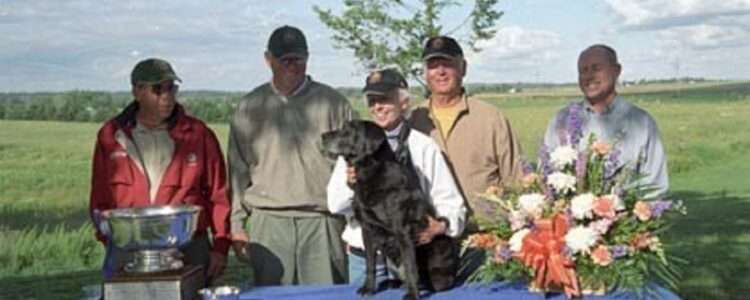
Named for her birthplace in Georgia, Chicka made a name for herself running in field trials.
Chicka’s early years
Her intense retrieving drive was apparent while she was still with her littermates. Her owner said, “She would whirl, twirl and do somersaults” to retrieve anything thrown.
At four months she won a Puppy Stake against dogs more than twice her age. She did it by swimming across a large pond full of sticks and lily pads.
Her career
At a bit over two years old, she won the first of three Double Headers. In all, she qualified six times for the National Open and seven times for the National Amateur. She was a finalist four times.
In 2004, she won the National Amateur with her owner, Lynne, handling.
Lynne described the fifth series, “There were 4 marks, 2 of which were flyers and 2 dead bird-retired marks. The longest of which was about 200 yards. The flyers were visually close to each other and a high number of dogs had to be handled. It was a beautiful series set in a hay bale field with interesting terrain but the hay bales did confuse the dogs. We had all kinds of weather…from hot to cold and rain to sun, plus difficult winds. Additionally, it was a ‘mixed bag’ of birds, which is the most difficult form of retrieval in terms of game. The dogs become keyed into the scent of the first bird retrieved. Then have to re-focus on very different scent for subsequent birds of different species. It really was a make or break series.”
Injuries
What makes Chicka’s career even more impressive is the injuries she overcame. In one surgery, she had two ruptured lumbar spinal discs removed. Another surgery was a total replacement of her right hip. She spent more time in rehab than in training in the 2-1/2 years before her National win.
Chicka was also featured in a magazine for disabled sports men and women.
Pedigree
| 2xNAFC 2xCNAFC FC CFC Ebonstar Lean Mac | CNFC CNAFC Waldorf’s High Tech | CFC Rascal’s Super Spud |
| Itch’s Flying Tiger | ||
| Ebonaceae Princess WCX QAA | Trieven El Conquistador | |
| Skookum’s Sky Raider | ||
| Lazer’s Razor Sharp MH | FC AFC Donnybrooks Rocky Road | FC AFC Connies Little Thunder |
| Raintree Farms Mint Julep | ||
| Snakes Midnight Lazer MH | Spider Man II | |
| Snake’s Whistling Wind |
Famous relatives
Chicka was sired by Ebonstar Lean Mac and out out of Lazer’s Razor Sharp MH. She also descends from NFC 2xNAFC Super Chief (Hall Of Fame) and his relatives:
- FC AFC Air Express HOF
- FC AFC Ithin’ To Go
- FC AFC CFC Trieven Thunderhead HOF
- CNFC FC Wanapum Darts Garbo
- Super Powder QAA
There are many other great Labs in her pedigree, including National Field Champions and National Amateur Field Champions. Some have also been inducted into the Hall of Fame.
Plus there are show champions, English imports and dual champions, including 3xNFC CFC Dual Ch Shed of Arden HOF.
Although she may be the best known dog in her litter, there are other titled dogs. Her brother, Law Abiding Ezra, earned his FC and AFC plus an Obedience Trial Championship (OTCH). Ezra also sired a daughter who earned her OTCH plus UDX2 and MH.
Other siblings have field championship and/or hunt test titles. Then you could spend hours looking through the list of half-siblings sired by her father.
NAFC FC Chickamauga Choo Choo
Whelped: May 21, 1996
Died: Dec 5, 2008
Owners: Lynne and Mac DuBose, Hillsborough, NC
Breeders: Vincent and Phyllis Garner
Registration: SN36231305
Accomplishments:
34 Derby points
QAA before 2 years old
3x Double Header winner
64.5 Open points
120 Amateur points
National Amateur Field Champion
2012 Retriever Hall of Fame
Glossary:
CH – Show Championship
FC – Field Championship
AFC – Amateur Field Championship
NFC – National Field Champion
NAFC – National Amateur Field Champion
CFC – Canadian Field Championship
CAFC – Canadian Amateur Field Championship
CNFC – Canadian National Field Champion
Double-header – to win both the Open and Amateur stakes at the same field trial
QAA – Qualified All-Age
MH – Master Hunter
OTCH – Obedience Trial Championship
UDX – Utility Dog Excellent obedience title
HOF – Hall of Fame

